Kono (New York, NY)
Yakitori Kono
46 Bowery, New York, NY 10013
646-524-6838
www.yakitorikono.com
Sat 02/24/2024, 05:30p-09:40p
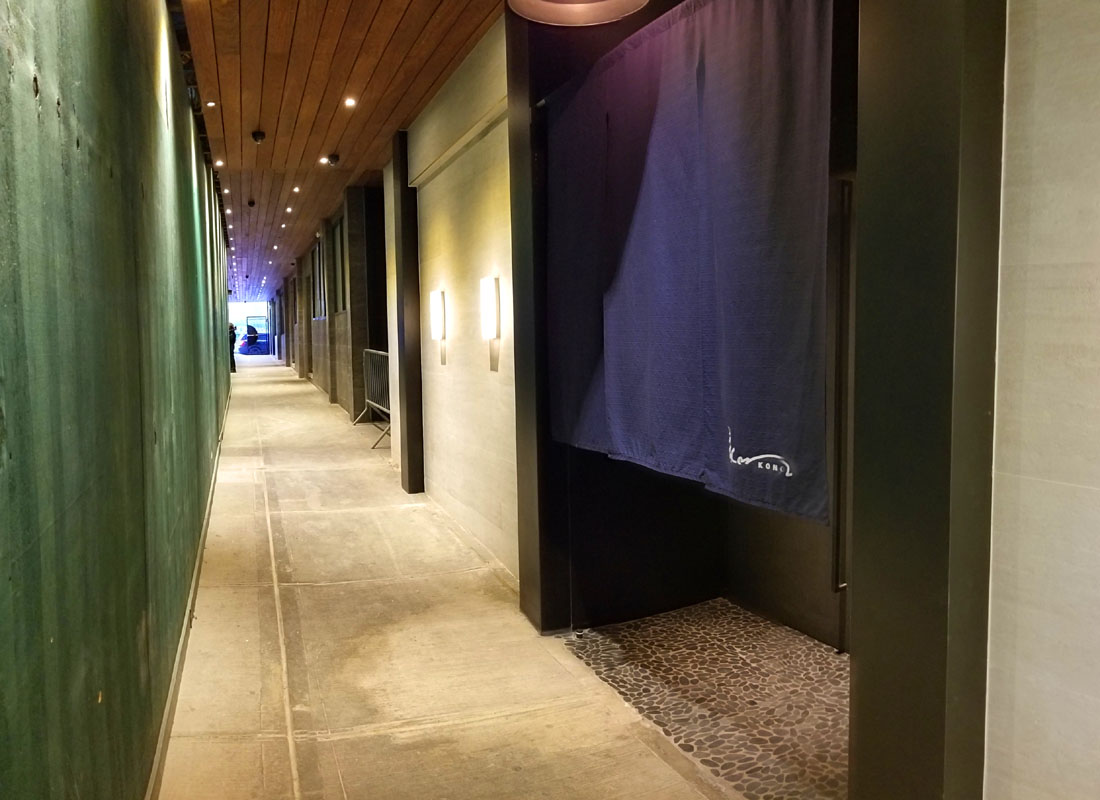
If you read my last post, you'll know that I recently visited Torien, where the team served me the best yakitori meal I've had in the US. However, not content with just one stellar chicken skewer experience, the following day I made my way to Kono, which is oft considered Torien's closest competitor. The Chinatown restaurant bowed in April 2022, and is the brainchild of Atsushi Kono, the former head chef over at yakitori stalwart Torishin.
About the Chef: Kono Atsushi (河野睦/こうのあつし) was born in February 1982, and hails from Kitamoto, Saitama Prefecture. Around age 12, he started helping out at his parents' restaurant and fish market, though he was more interested in b-boying at this point. In fact, he eventually became one of the top breakdancers in Japan, and later taught, choreographed, and even joined the influential Rock Steady Crew in 2002. During this period, he also attended Musashino Culinary Institute, and following completion of his studies, trained at Kyorori Suzuyoshi (京料理 鈴よし), a Kyoto-style kappo in Akasaka, Tokyo. Further training occurred at a Chinese restaurant, at another Japanese spot, and at an outpost of well-regarded Kyoto eatery Tankuma (たん熊).
In 2006, Kono moved to NYC to advance his hip hop and DJ career. However, he needed another job in order to make ends meet, and was thus hired by Chef Shu Ikeda in April 2006 to help with the opening of Yakitori Torishin. He was sent to train at Toriyoshi in Tokyo, which is where Ikeda-san himself apprenticed. Torishin ended up debuting in 2007, and Kono was named head chef there just a year later. During his tenure, the restaurant was awarded a Michelin star (October 2011), which it maintained until the 2019 edition of the guide (released November 2018), and also received a three-star review from Pete Wells over at The New York Times (April 2017). In October 2016, the Chef got married to Nozomi Higashi, and they would later have daughter Kiko in December 2021.
Despite all the acclaim, Kono would leave Torishin in March 2019 to serve as CdC for Michael Jong Lim at Chikarashi Isso, a kappo-inspired offshoot of fast-casual poke spot Chikarashi. Part of Kooth Hospitality (Jonathan Chu, Ivy Tsang, Selwyn Chan, along with Chef Lim), Chikarashi Isso launched in early December 2019 in the Financial District. When the pandemic struck, the Chef pivoted to a Chikarashi Isso-branded yakitori pop-up at Hotel 50 Bowery (developed by Chu's family, a major landlord in the area), which ran from October 2020 to the following July; the actual Chikarashi Isso, meanwhile, closed in late 2021.
By January 2022, he and the Kooth group had already started work on Kono, and the restaurant grand-opened on April 25th that year. Three months later, Pete Wells rated the place three stars, and the following April, the yakitori-ya made its way onto the Times' "100 Best Restaurants" list, at #23. In September 2023, Kono was deemed one of Bon Appetit's "Best New Restaurants," while just this January, Kono was named a "Best Chef: New York State" semifinalist by James Beard.

Kono occupies a space in the 1936-era Canal Arcade building (a.k.a. Chinatown Arcade, and also owned by the Chus) that was previously home to Family Plus Pharmacy. The space was completely re-envisioned by the Chef, in collaboration with BLANK Design, and the room now sports a dark-toned aesthetic inspired by the color of binchotan. Shown above is the view from my seat at one of the corners of the restaurant's 14-seater chef's counter, crafted from white oak and surrounding a sunken grill area. There's also a semi-private table off to the side that can accommodate up to six more guests.
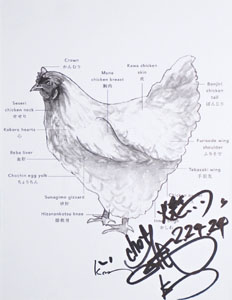
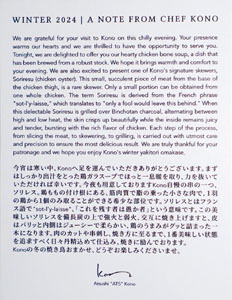
Tonight's yakitori omakase was priced at $175 per person. Unfortunately, you're not provided with an actual menu of the night's dishes, but you do receive the information card above, with a note from Kono-san and a handy chicken diagram (the Chef uses Amish birds I'm told). Click for larger versions.
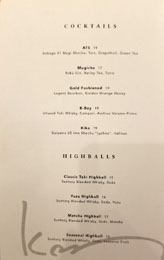

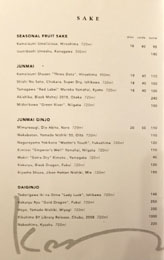
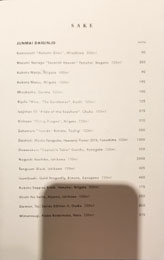
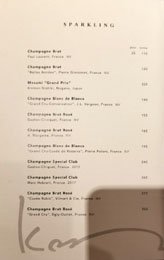
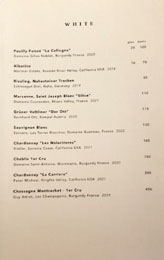
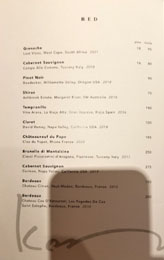
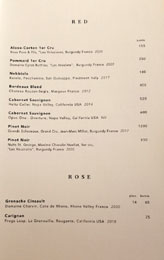
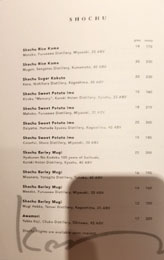
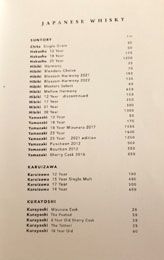

And here we see Kono's beverage selection, which is managed by GM Louis Andia (ex-Chikarashi Isso). It's pretty respectable, with a suitable array of cocktails, beers, sakes, wines, shochus, and whiskies on offer. Click for larger versions.
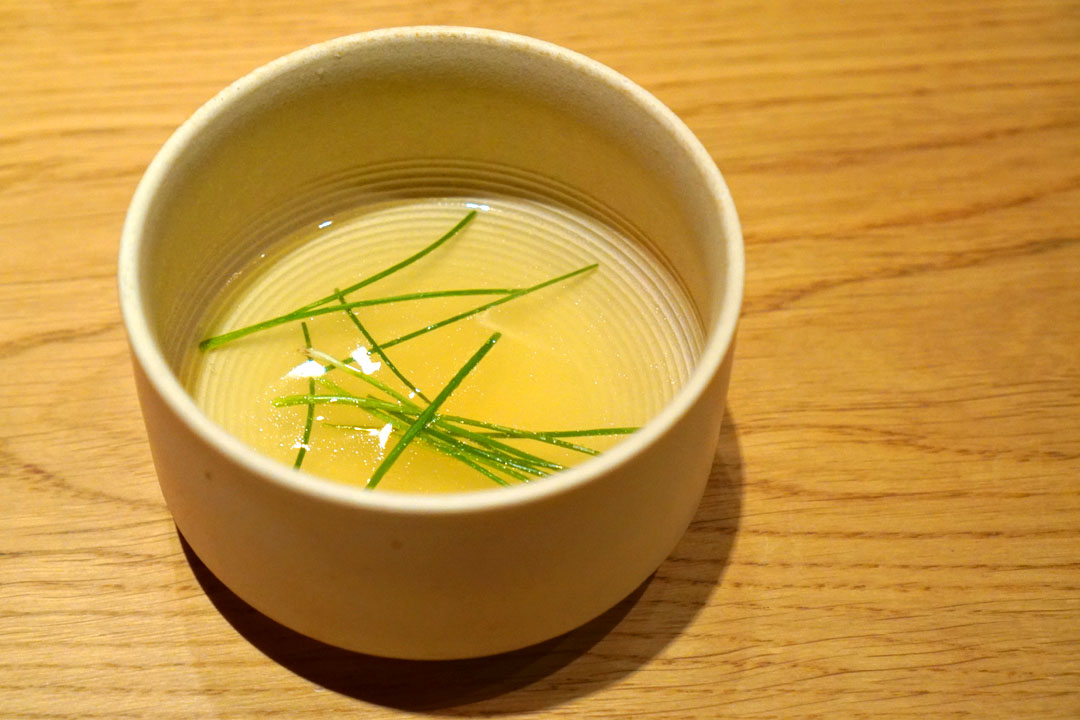
1: Consommé
Dinner commenced with a heady, concentrated, comforting chicken bone broth, one perked up by a pervasive ginger tang and threads of zesty scallion. A cozy start for sure.
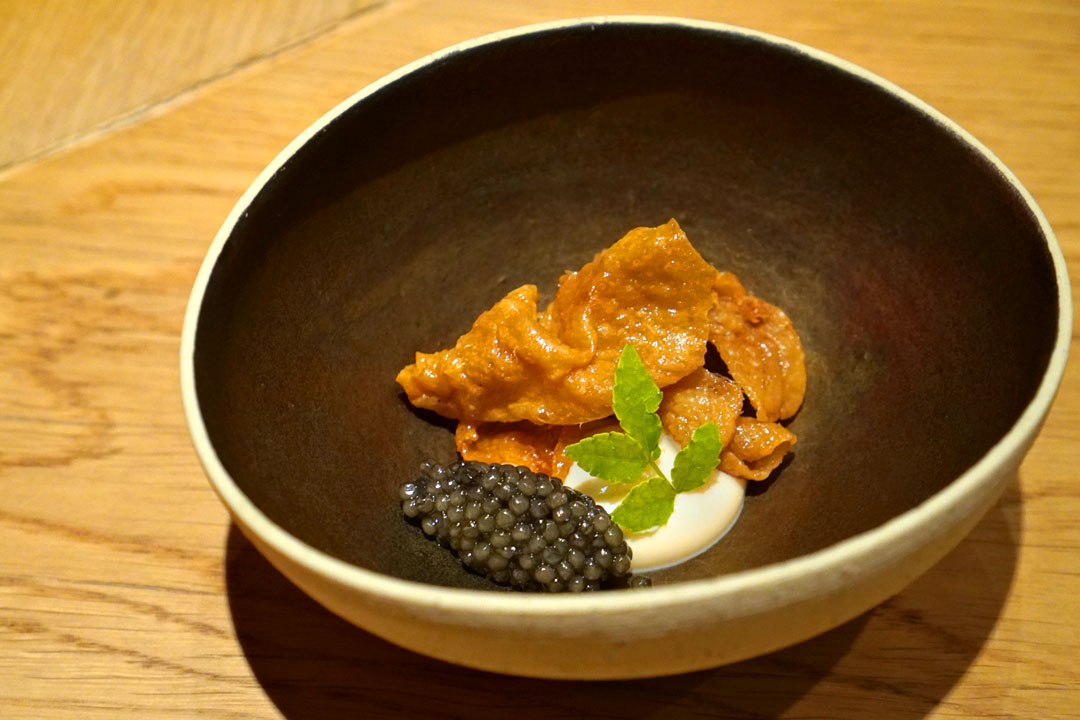
2: Torikawa, Golden Ossetra Caviar, Tofu Mayo
The saltiness of both Dutch osetra caviar and crispy chicken skin were juxtaposed here, softened by that silky tofu and the refreshing nature of shiso leaf.
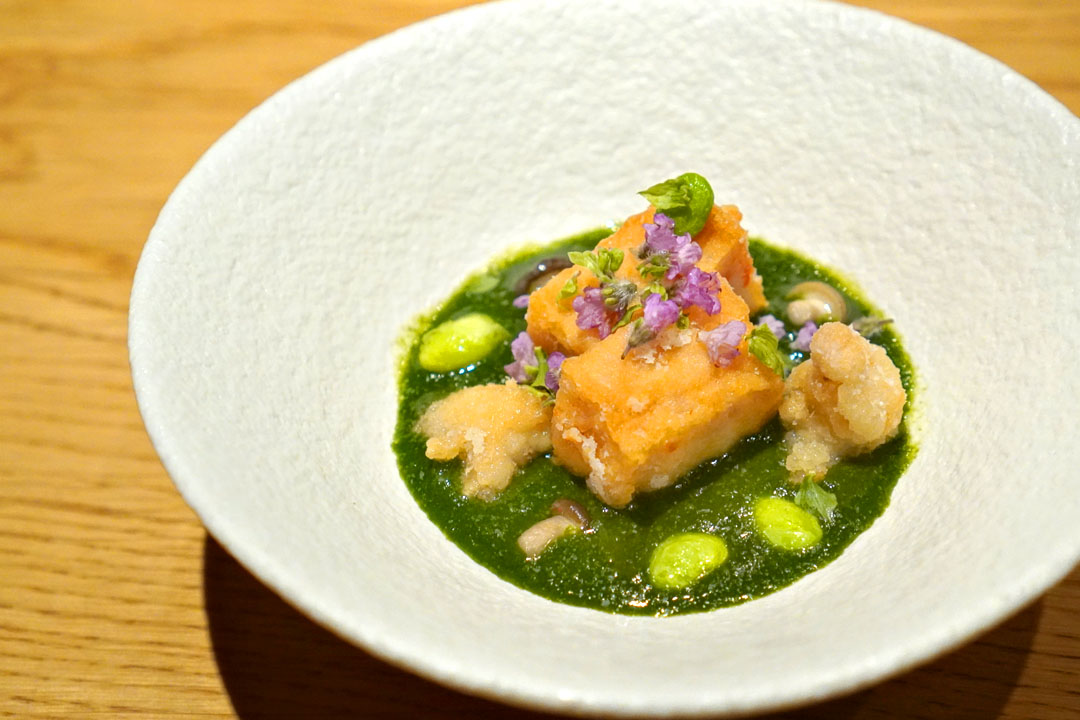
3: Shinjo, Bonjiri, Kiku
A shrimp-boosted fish cake conveyed a delectable sweet salinity that was complemented by savory bits of chicken tail. Those robust yet finessed flavors were then matched with edamame and more importantly, a wonderfully grassy chrysanthemum sauce that really uplifted the dish.
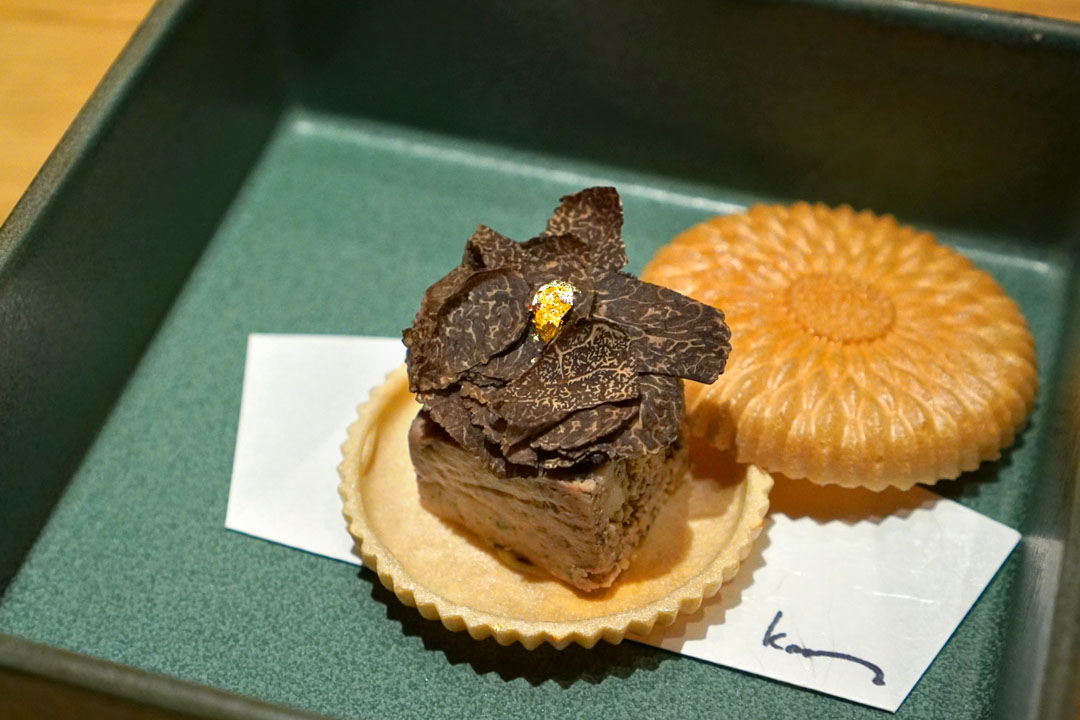
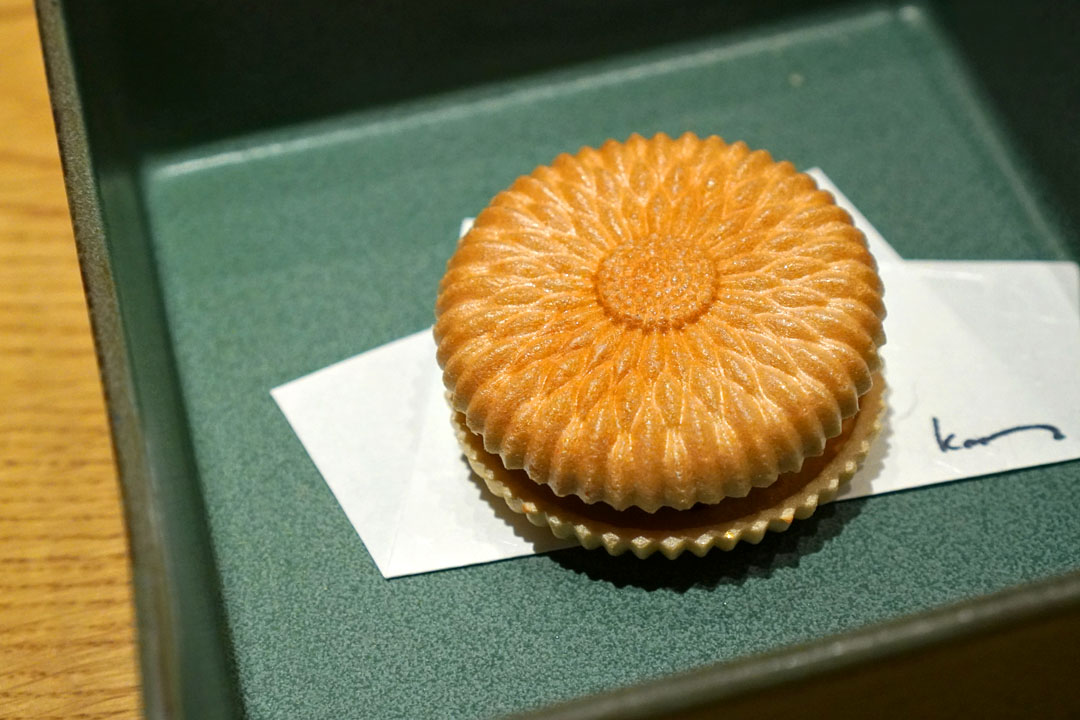
4: Reba, Black Truffle, Monaka
A chicken liver pâté ate sweet and earthy, melding perfectly with the musk of Alba truffle and those wafers, which were light, airy, and loaded with this senbei-like savoriness. A bit of a showstopper.
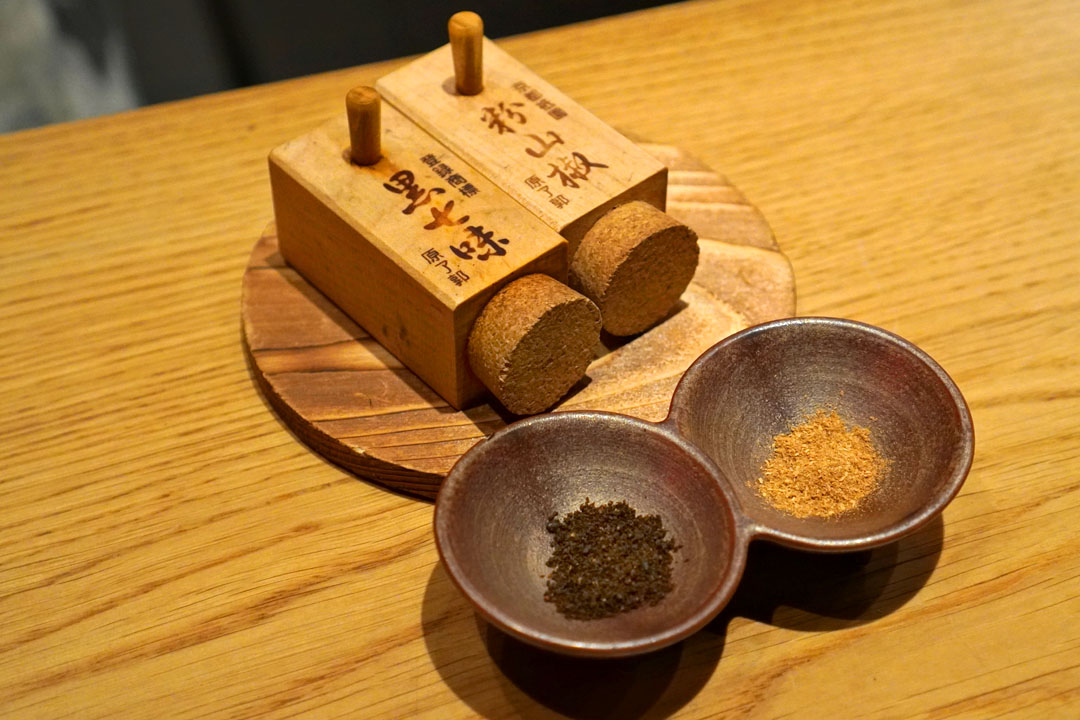
Condiments were sourced from Kyoto-based producer Hararyoukaku (原了郭), and included a classically sharp sansho (粉山椒), as well as kuro shichimi (黒七味), which had this deep, stinging, creeping, surprisingly potent heat that I thoroughly enjoyed.
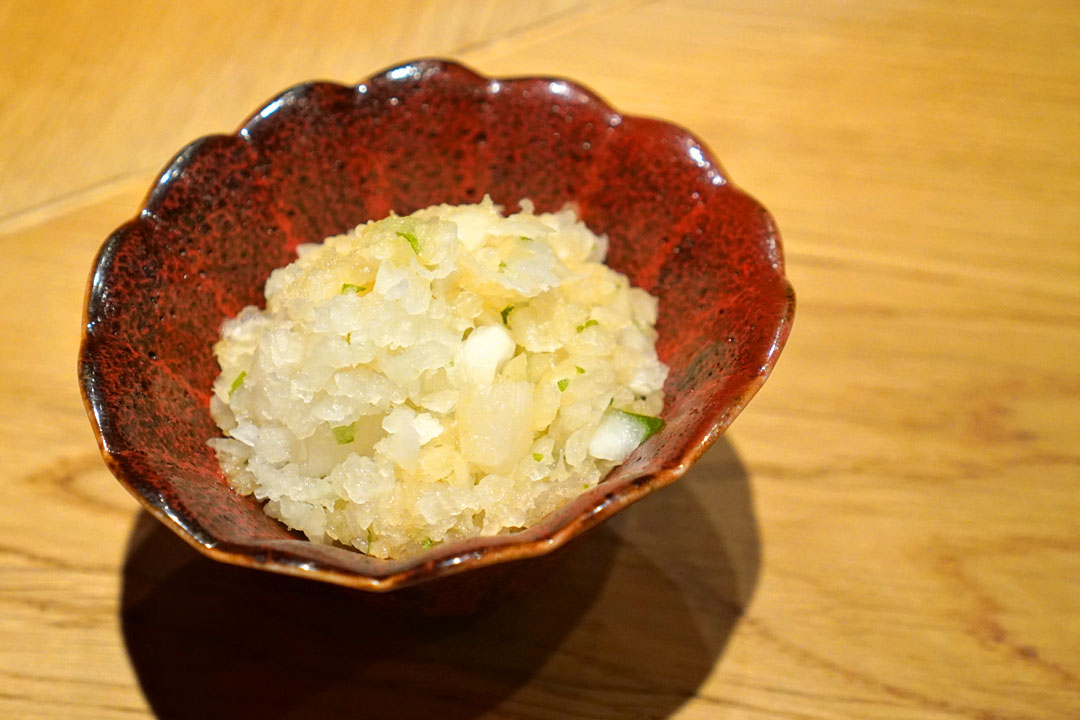
Rough-grated radish was brightened by the application of shiso.
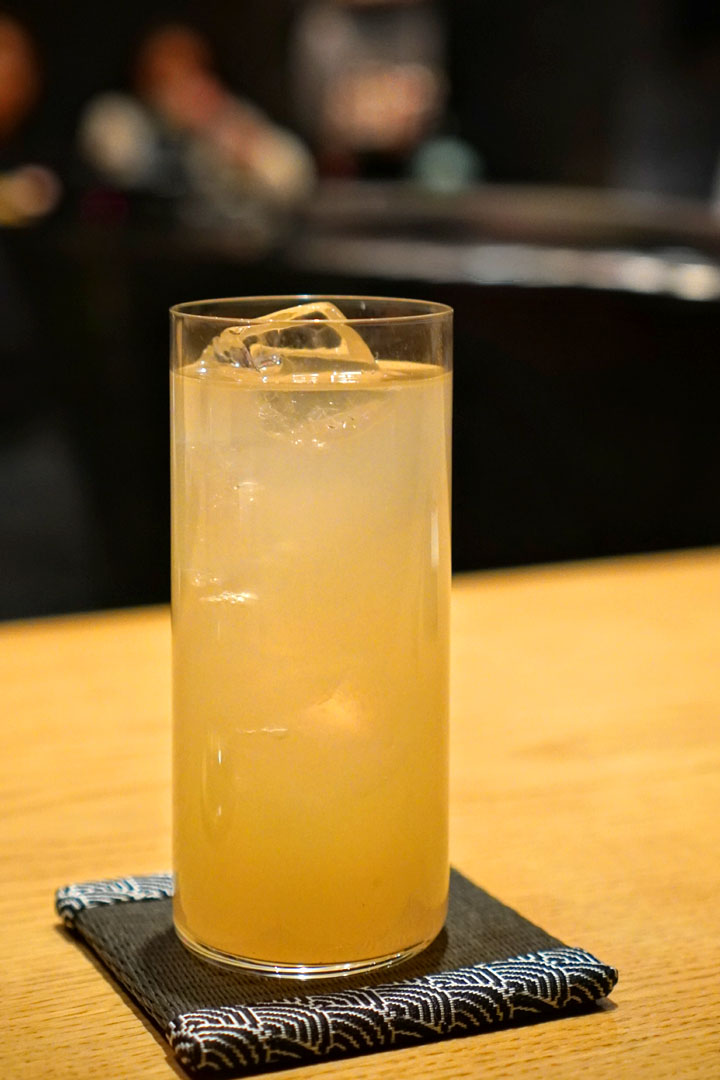
Seasonal Highball [$17.00] | Suntory Blended Whisky, Soda, Seasonal Fruit
I opted for cocktails this evening, and kicked things off with something on the lighter side. Tonight's seasonal fruit was apricot, and its presentation here was nearly candied, but things never got overly sugary thanks to the drink's boozy, whisky-fueled backbone.
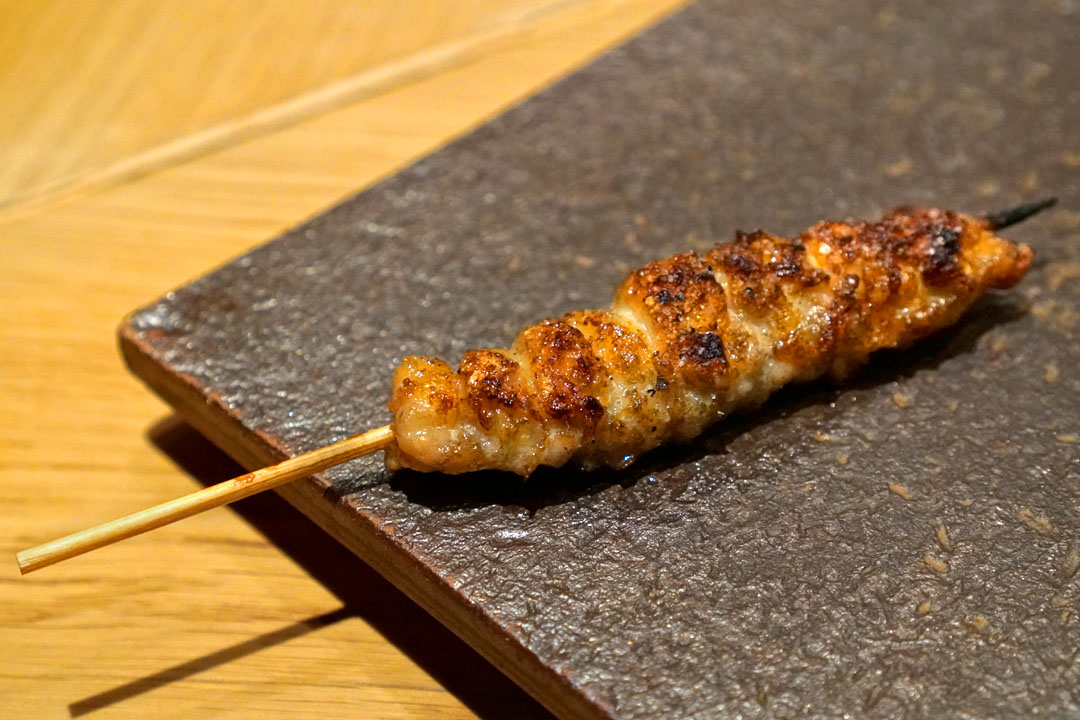
5: Bonjiri
Chicken tail is a favorite of mine, and Chef Kono made a bit of a statement by starting with it, since, given the cut's potency, it's generally served toward the end of a meal. In any case, I found the bird wonderfully salty and smoky, really standing up to the dark pepper, which actually seemed to draw out the bird's sweetness. Yum.
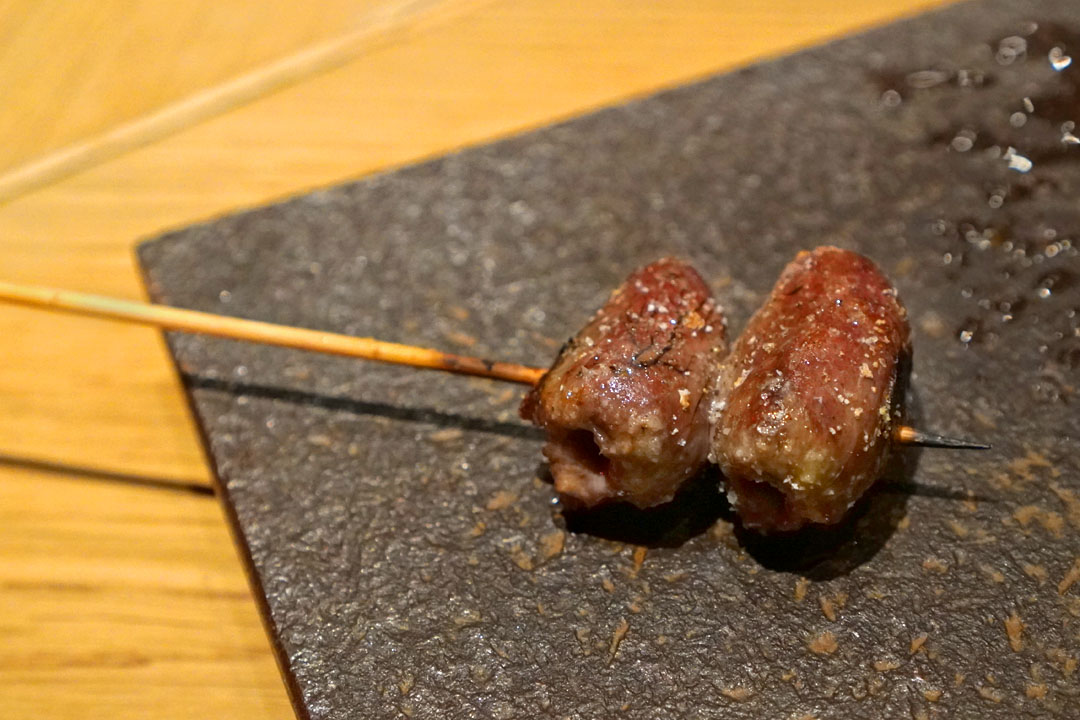
6: Kokoro
The heart was super juicy, with a nice chew and a refined earthiness that really took well to the prickly heat of sansho.
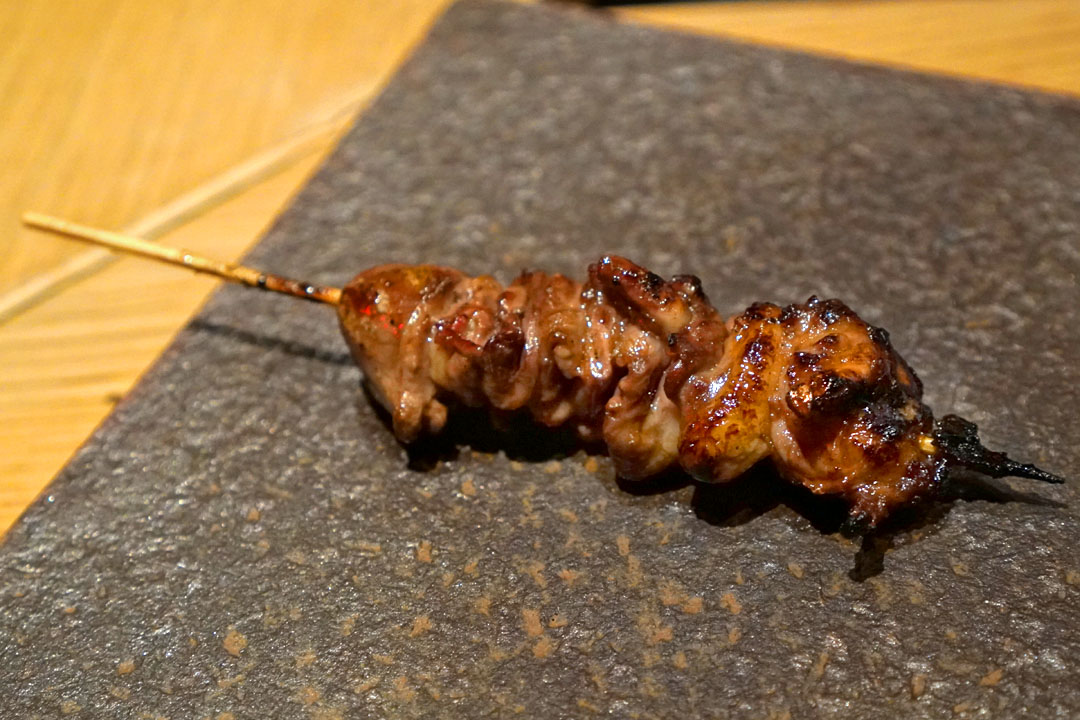
7: Hatsumoto
Arteries had a wonderfully supple bite, along with an initial smokiness transitioning to markedly sweeter flavors. The sansho worked here, but wasn't strictly necessary.
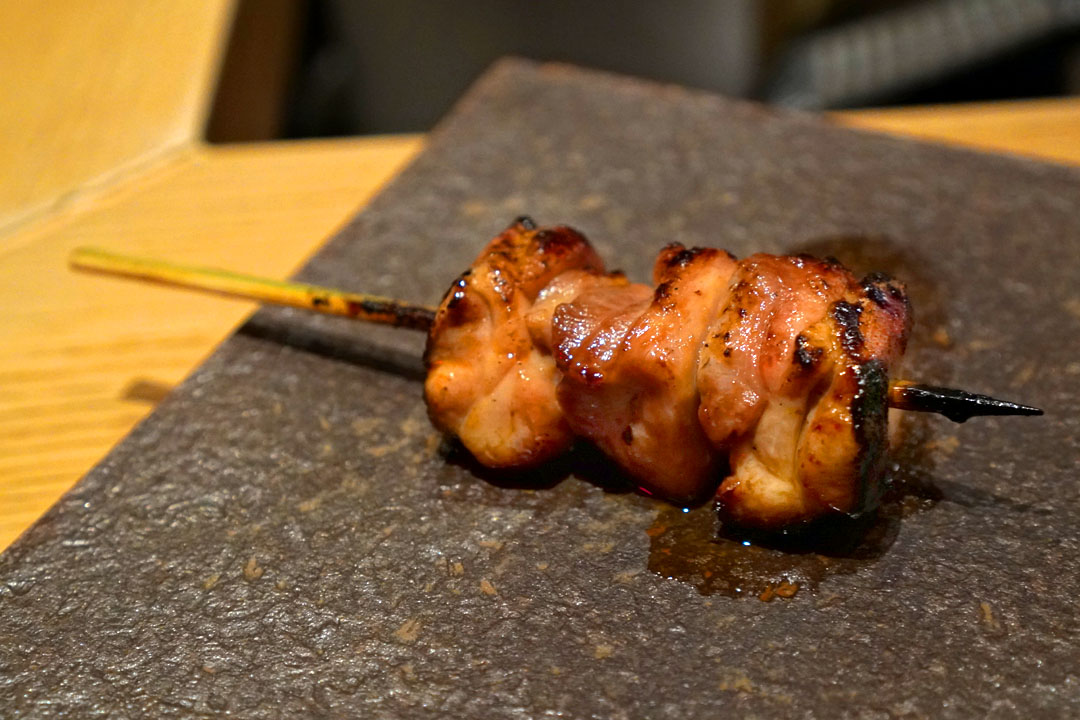
8: Kashiwa
Thigh was great texturally, and came loaded with a mouthwatering sweet char that turned almost fruity when the shichimi was applied. And if you're wondering why this was called kashiwa instead of momo, I was told that the former is the preferred term in the Kansai region.
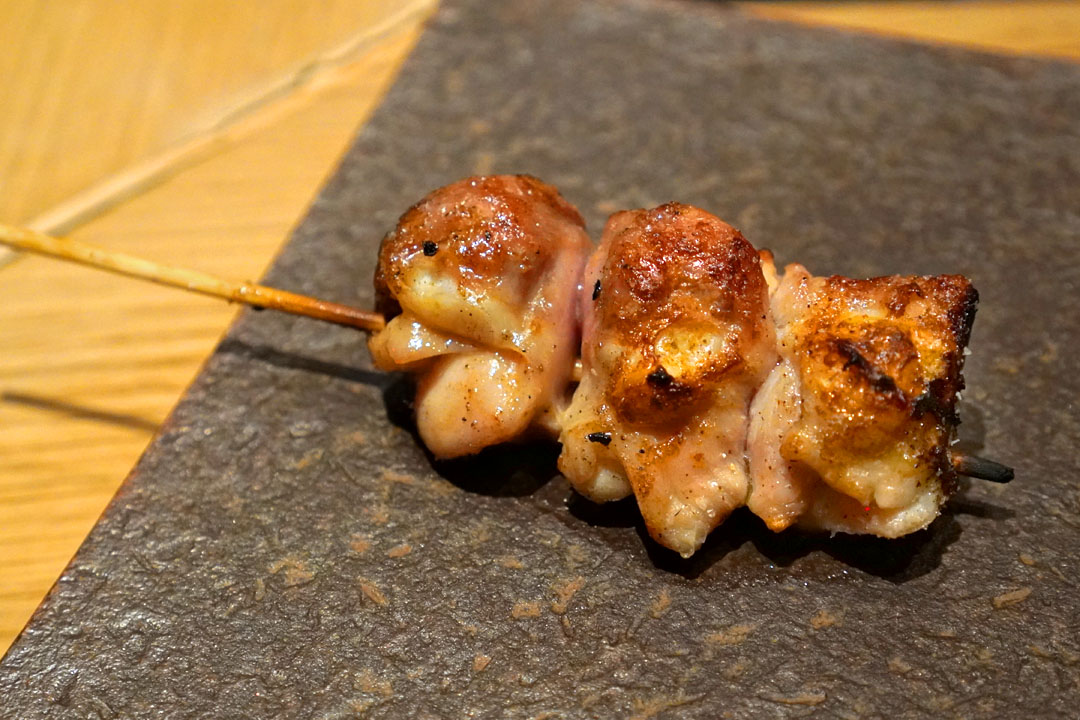
9: Hizanankotsu
Knee cartilage offered up a gratifying crunch along with a forceful dosing of smoke that really made a lot of sense here. Simply superb.
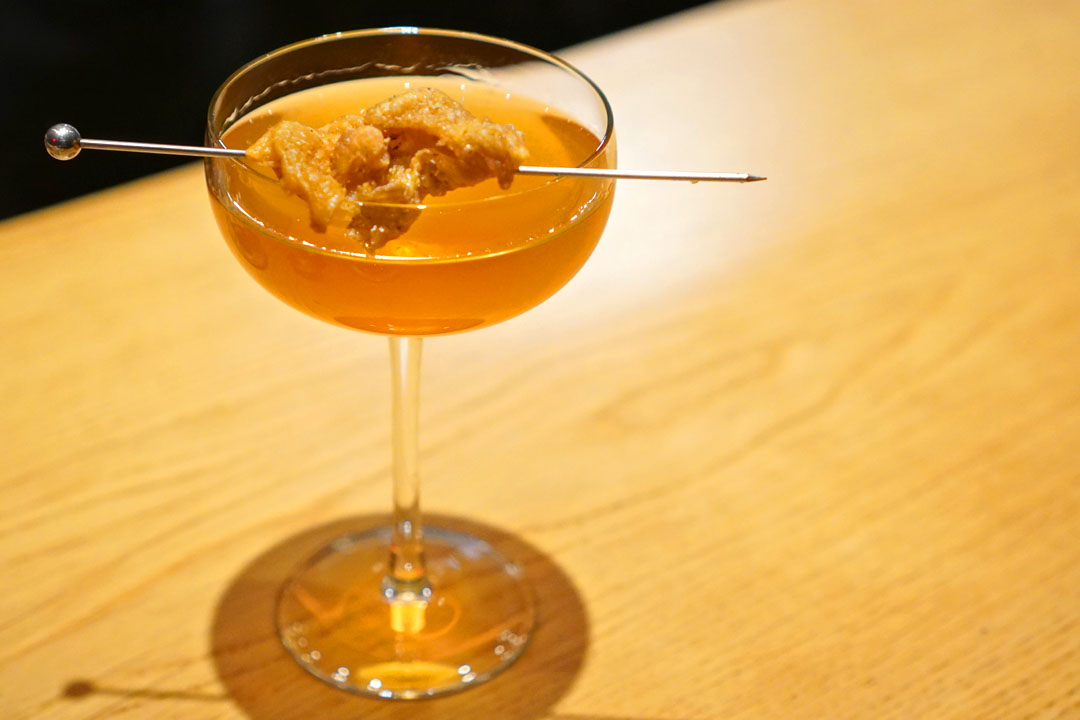
ATS [$19.00] | Aokage 41 Mugi Shochu, Tare, Grapefruit, Green Tea
My next cocktail was named after the Chef, as "ATS" is his moniker in the b-boy/hip-hop scene. This one wowed me a bit due to its immense, deep, long-lasting savoriness, foiled just enough by the citrus and tea. The drink was also garnished with a shard of fried chicken skin, which imparted further saltiness into the mix.
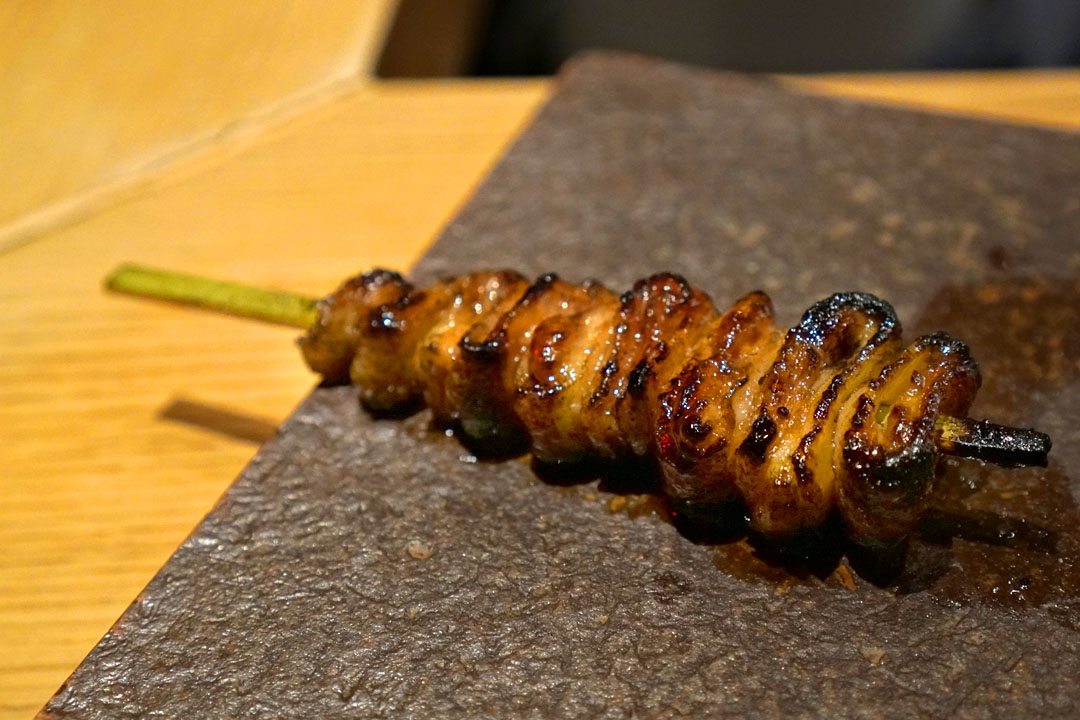
10: Toro Kawa
Belly skin showed off a tasty mix of fatty and crispy bits, along with a delightful sweetness that meshed effortlessly with elements of char.

Here we Kono-san and his assistant Aki-san (I believe that was his name) working the grill, fired with Kishu binchotan charcoal sourced from Wakayama Prefecture.

11: Harami
Chicken belly was a treat texturally, and was combined with the sweet-n-sour nature of ume paste and the unmistakable brightness of shiso.
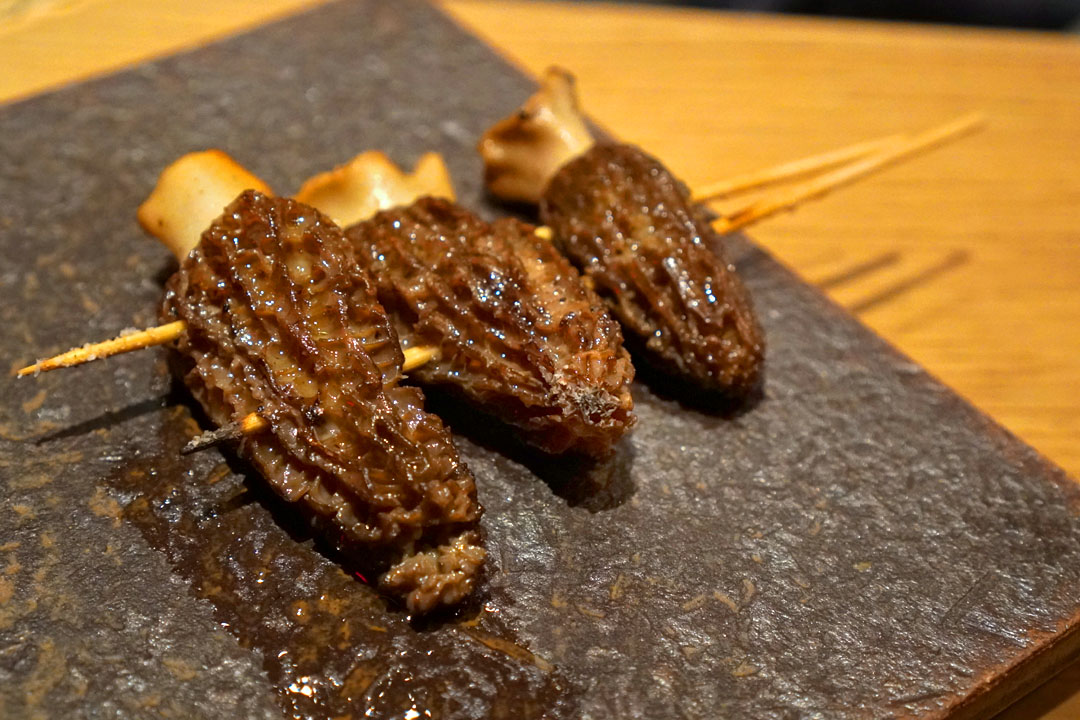
12: Amigasatake
Himalayan morels were intensely woodsy, and married perfectly with a savory tare sauce and even better with the dish's healthy dosing of butter.
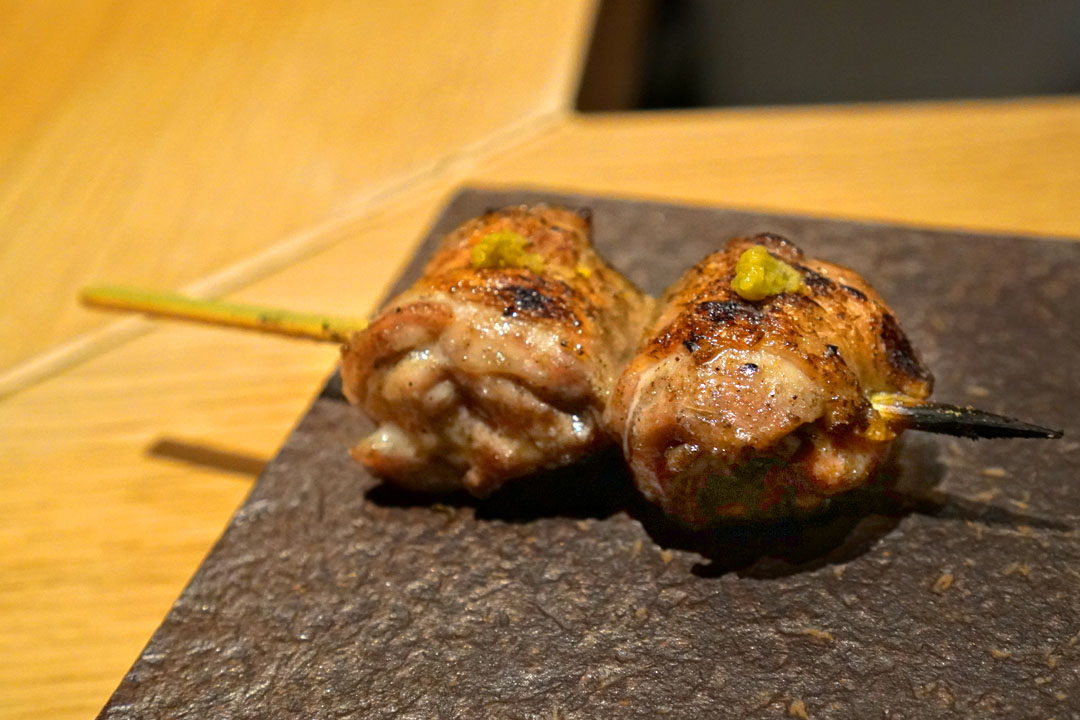
13: Soriresu
Chicken oysters showcased a fantastically slick, tender texture and a robust flavor profile that was further heightened by yuzukosho and plenty of char on the skin. This is apparently one of the Chef's signature skewers, and I can see why.
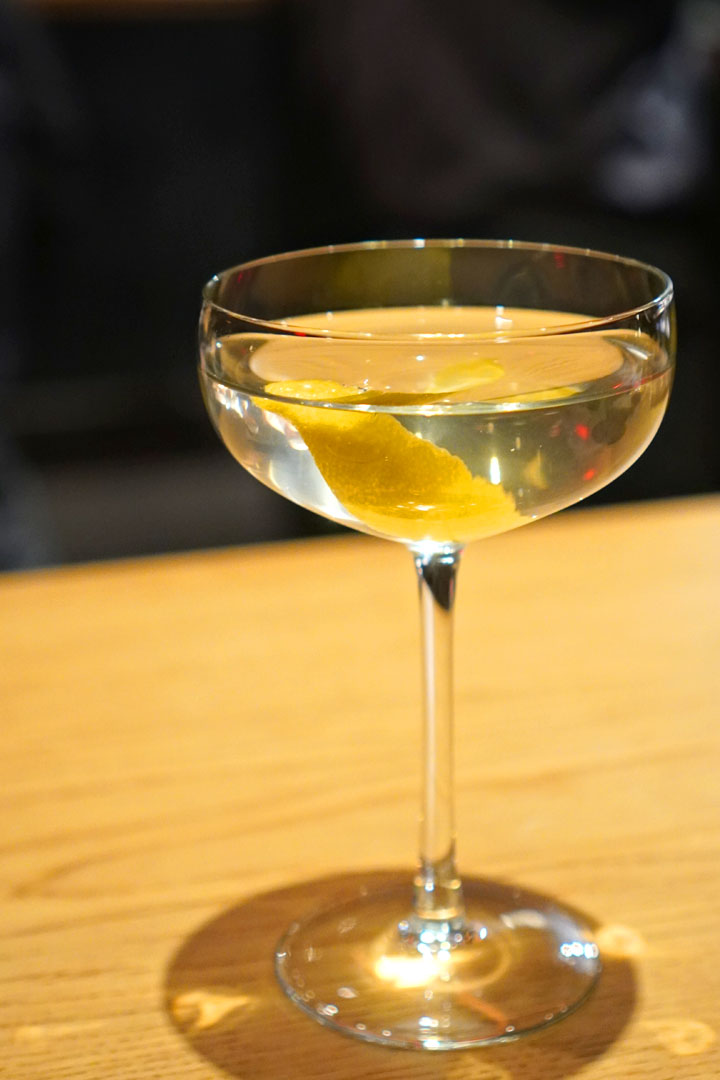
Kiko [$19.00] | Daiyame 25 Imo Shochu "Lychee", Italicus
This next cocktail took its name from Kono-san's daughter. The drink was well integrated, effortlessly combining loads of floral, sugary nuances with a marked bitterness from the bergamot liqueur.
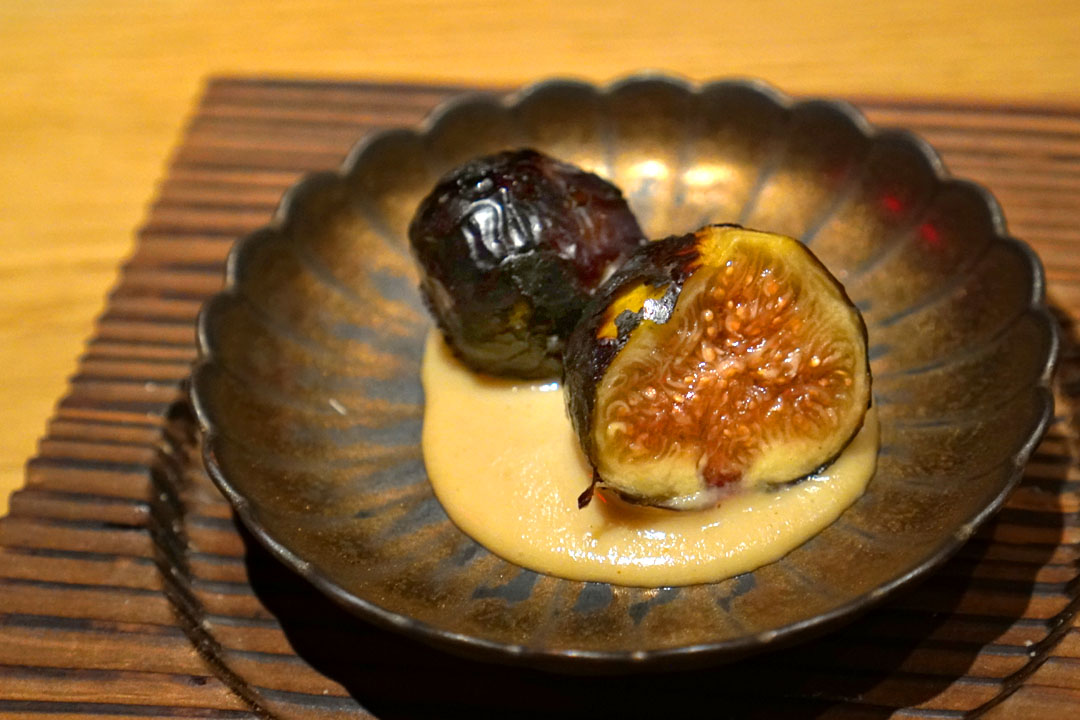
14: Ichijiku
I'd never seen fig before at a yakitori-ya, but the fruit worked out quite nicely due to how its sweetness paired with the nuttiness of a miso sauce.
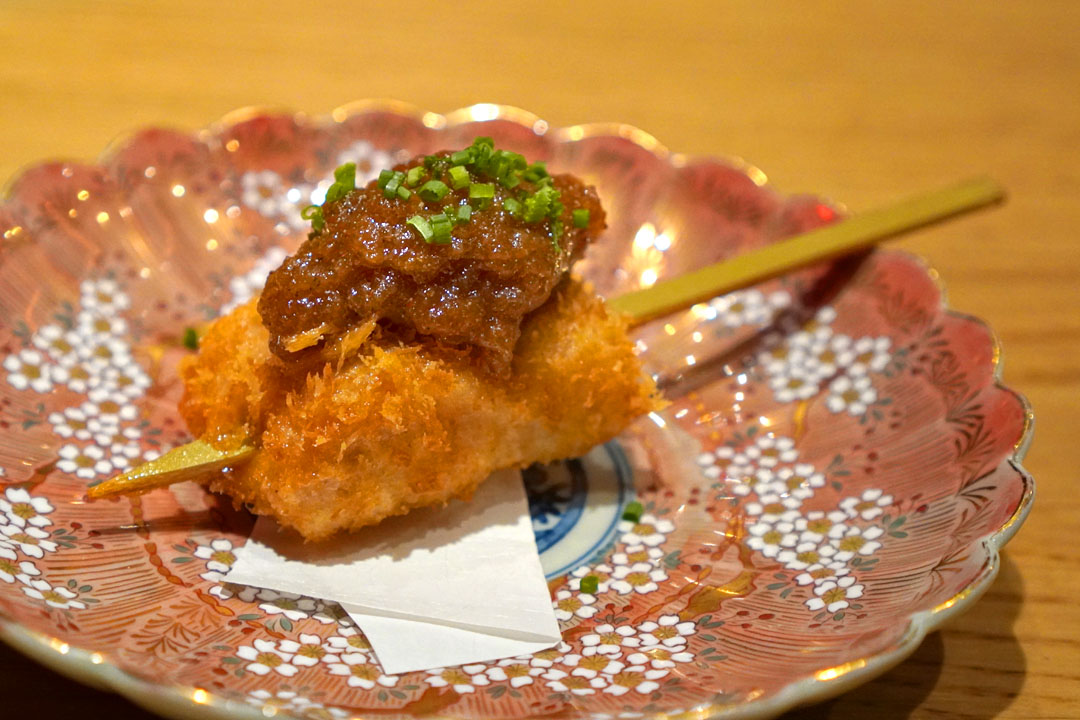
15: Tori Katsu
The chicken katsu was also unexpected. I was a fan of the bird's spot-on panko crust, while its juicy, savory interior played well with the sugariness of apple sauce.
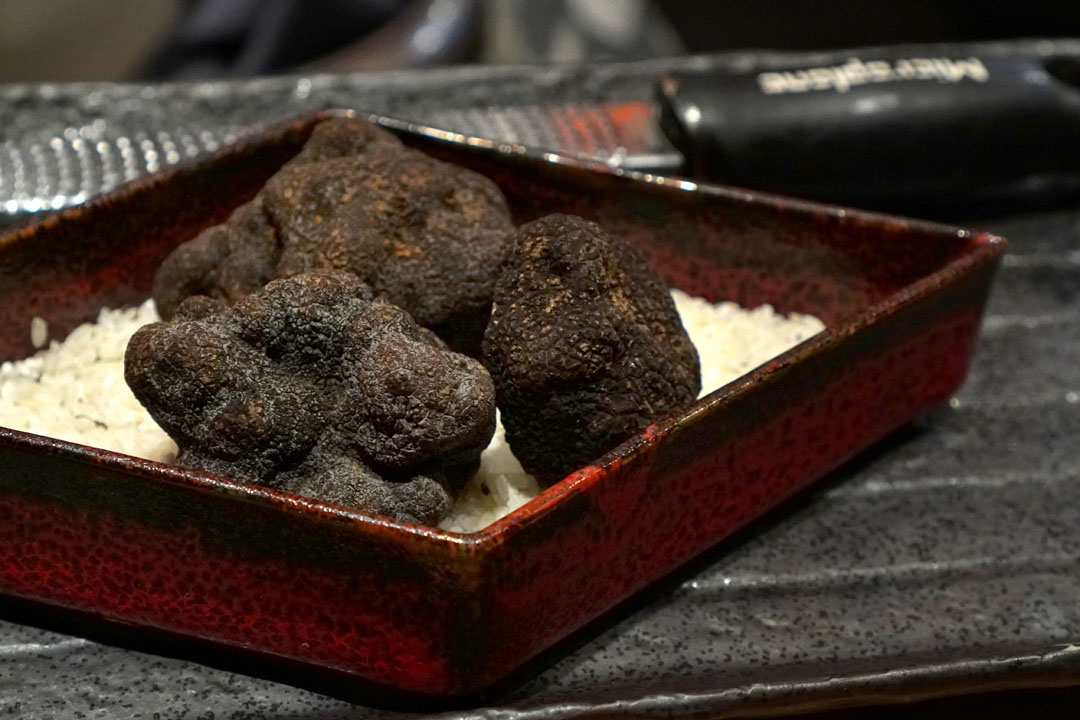
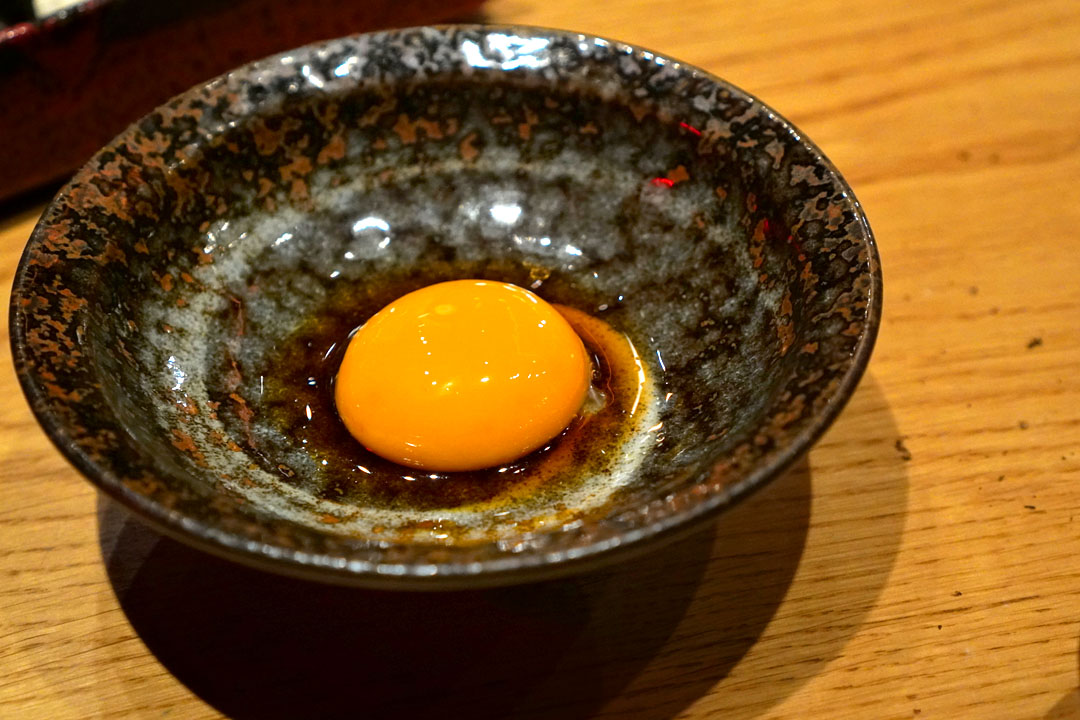
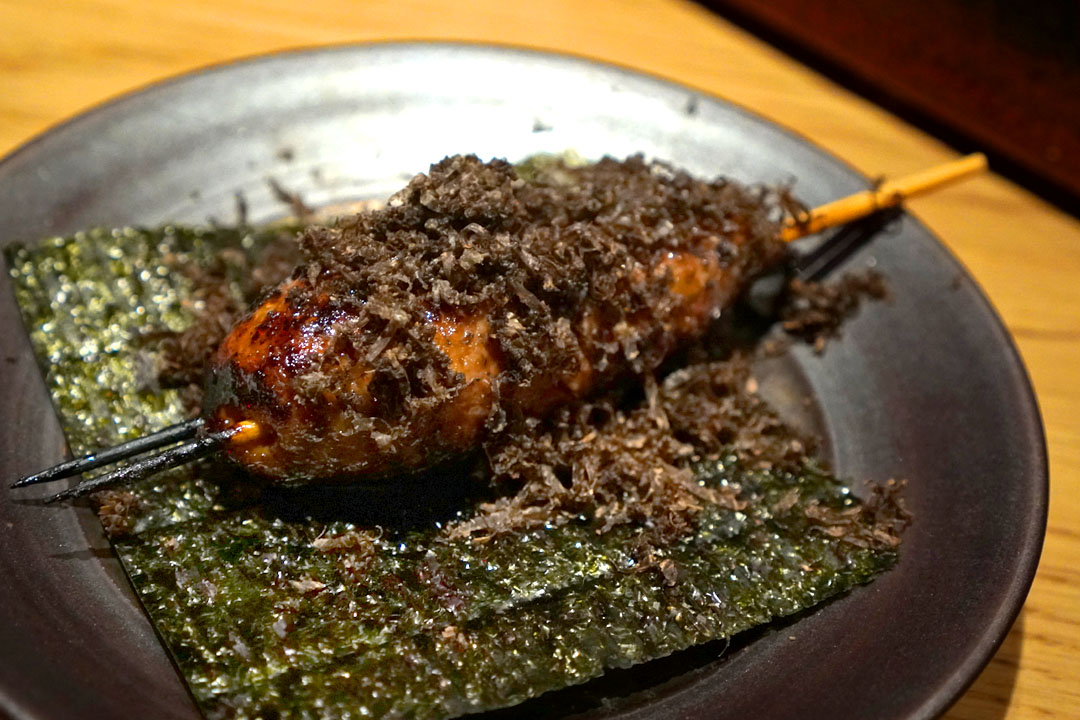
16: Tsukune + Alba Truffle [+35.00]
Meatballs were comprised of duck breast and chicken thigh, and delivered in spades both in terms of taste and texture. The addition of a seaweed wrapper was also appreciated, as was that runny egg yolk. And as for those musky shavings of black truffle? Did the dish need them? No. But was it better with them? Oh yeah.

At this point, I was presented with a case of optional items to supplement my meal with. Not surprisingly, I added on each and every one. However, I will say that venturing into other meats (i.e. pork, beef) isn't really necessary, since Kono-san's chicken is easily strong enough on its own.
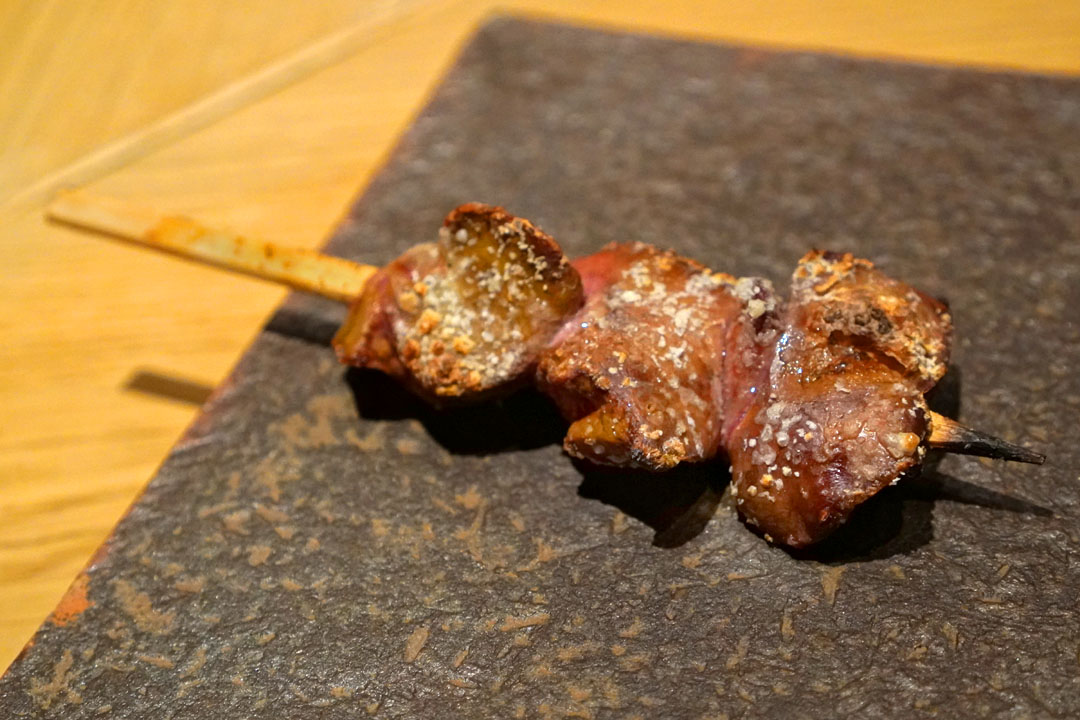
Supplement: Reba [$10.00]
Liver was cooked rarer than usual, which I much prefer, and thus ate softer and slicker than one typically finds, while the organ's signature earthiness was set off beautifully by pinpricks of salt.

B-Boy [$19.00] | Infused Toki Whisky, Campari, Archivo Volume Primo
A nod to Kono-san's breakdancing past, this cocktail highlighted the bitterness of the Campari-vermouth duo up front, before transitioning to a cacao-esque sweetness interspersed with a baijiu-like earthiness.
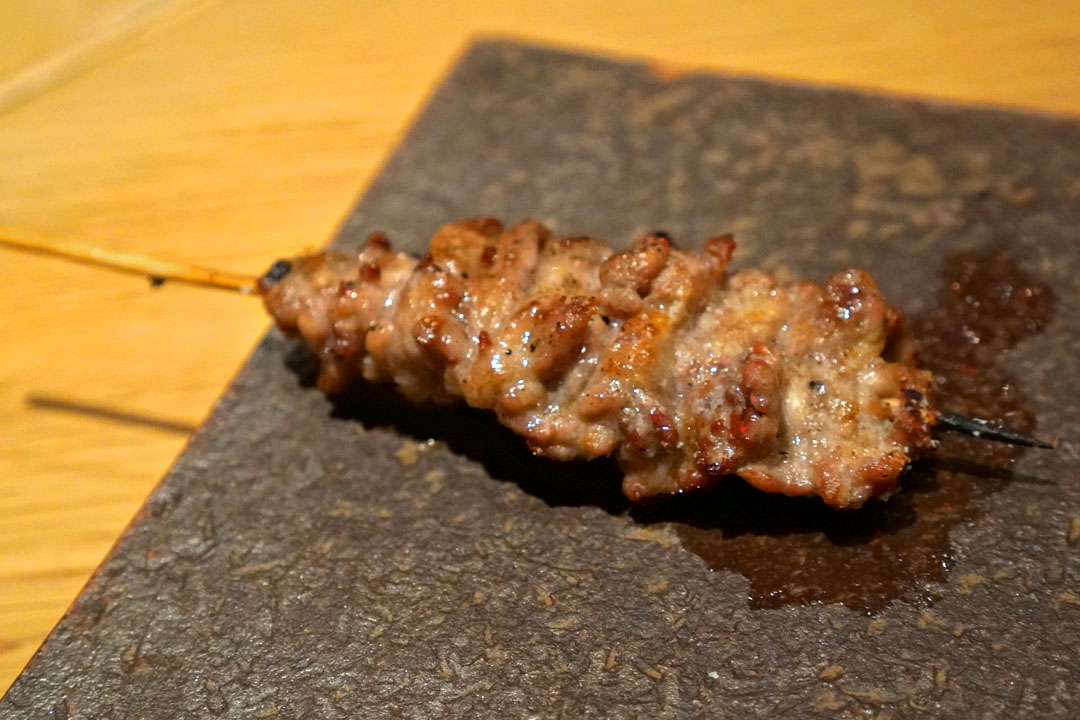
Supplement: Seseri [$12.00]
Chicken neck was a textural treat, and demonstrated a mouthwatering saltiness that was somehow tempered by all the smoke going on.
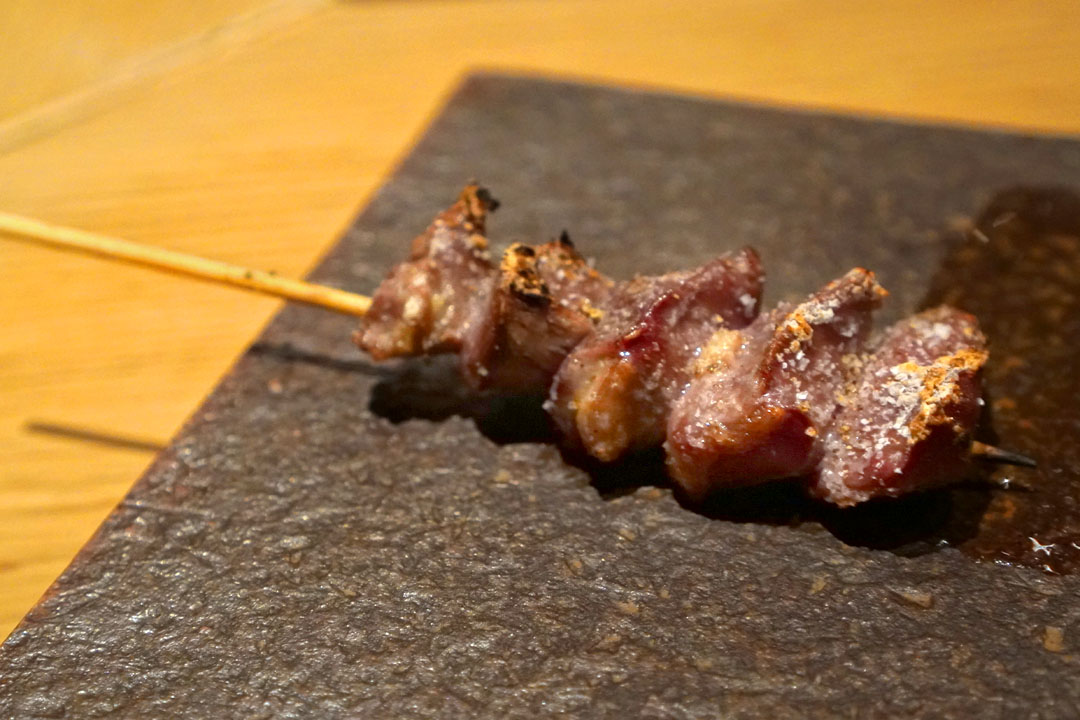
Supplement: Sunagimo [$8.00]
The gizzard was my server's favorite skewer, and I can see why. I just loved the sheer crunch of the offal, not to mention its agreeably salt-n-peppery flavors.
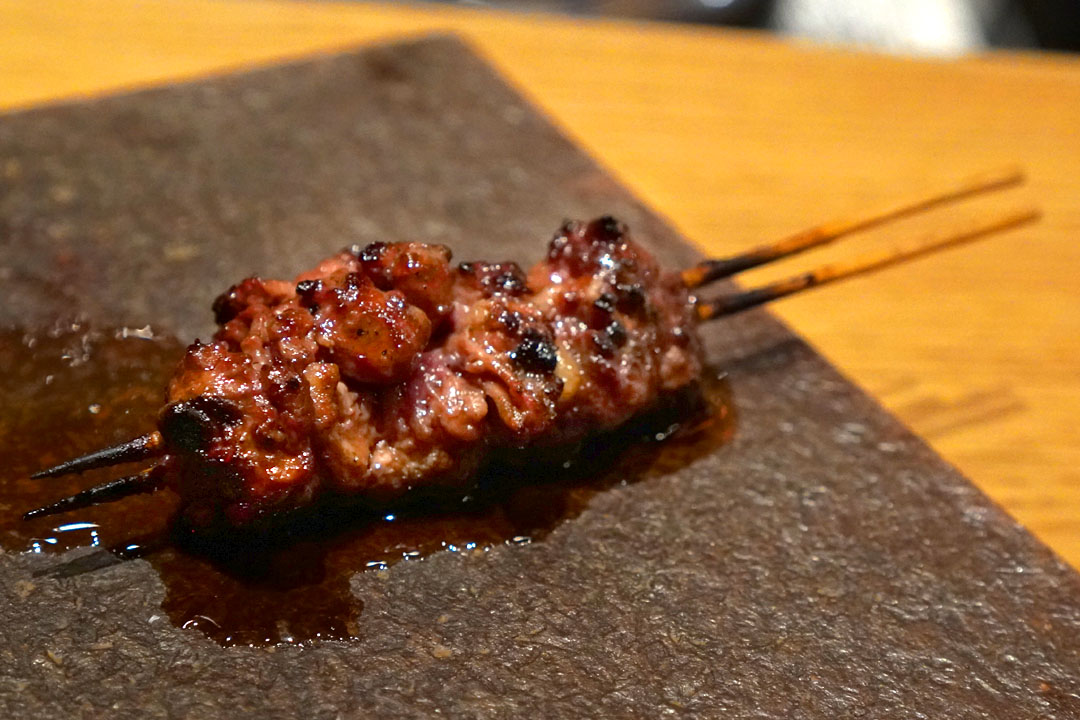
Supplement: Jinzo [$12.00]
Chicken kidney was a new one for me. I found it chewy and sinewy, with a liver-like earthiness that served as a great foil for contrasting elements of sweetness and sear.

Supplement: Eringi [$12.00]
Eryngi mushrooms conveyed a powerful, woodsy umami, and combined like clockwork with the dish's buttery components and a garnish of fried shiso.
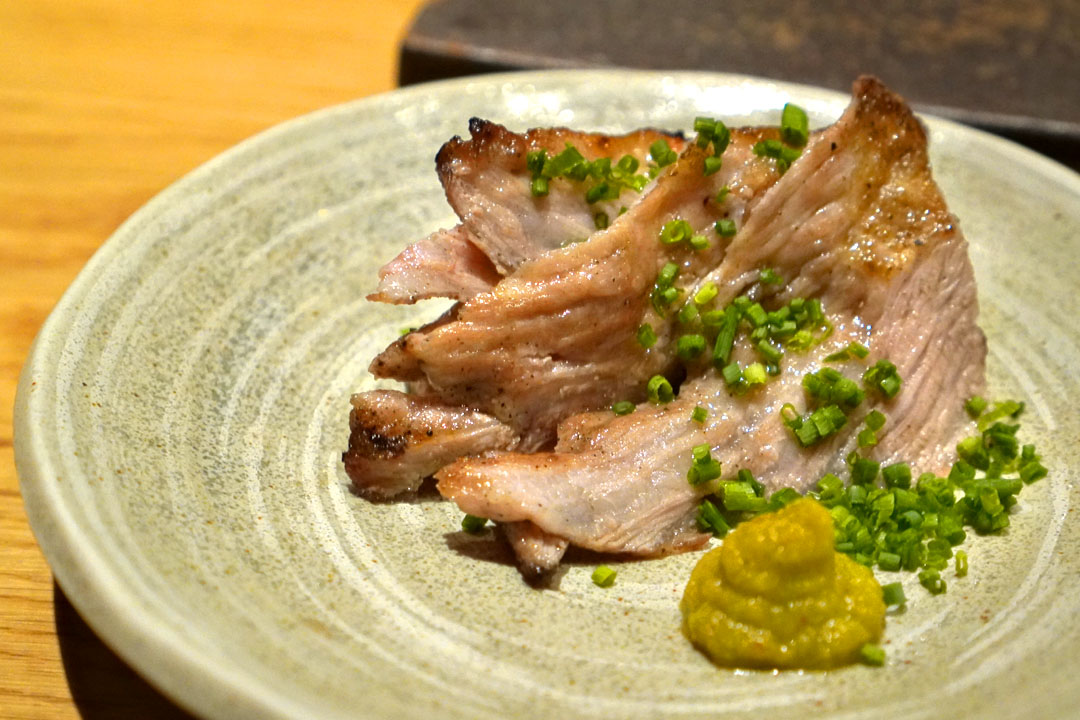
Supplement: Ibérico [$25.00]
Shards of ibérico had that porcine depth I was looking for, and really opened up when taken with the sting of yuzukosho.
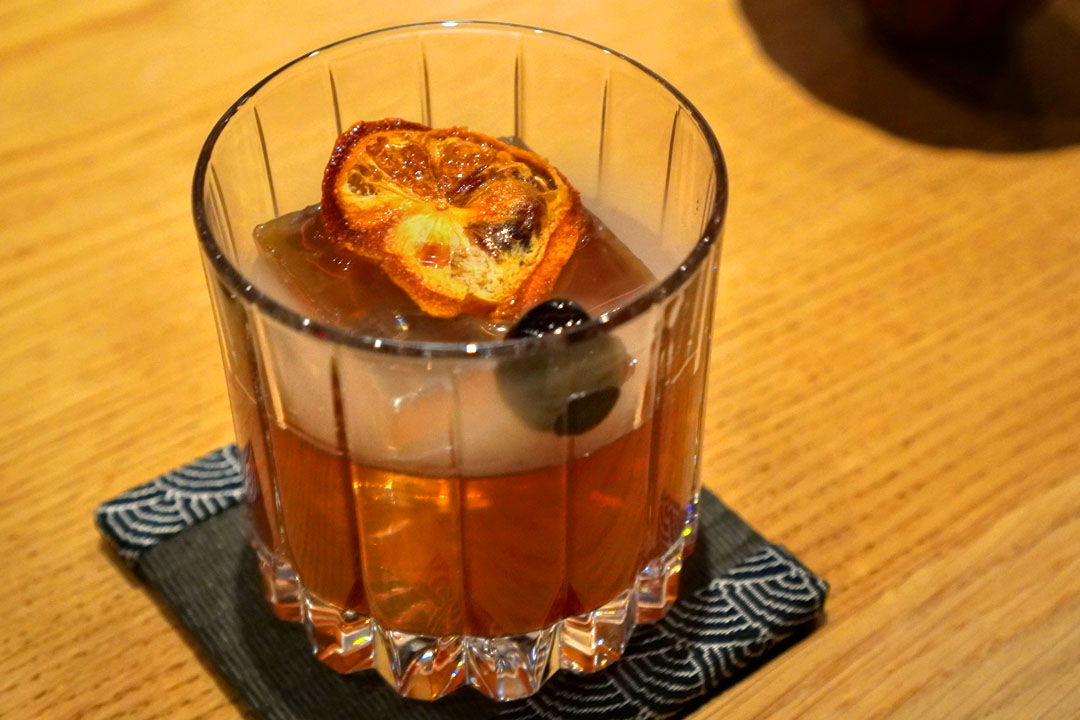
Gold Fashioned [$19.00] | Legent Bourbon, Golden Orange Honey
My final cocktail was an old fashioned variation, and featured a wonderfully woodsy, aromatic smoke, alongside a bevy of sweet, bitter, and boozy nuances.
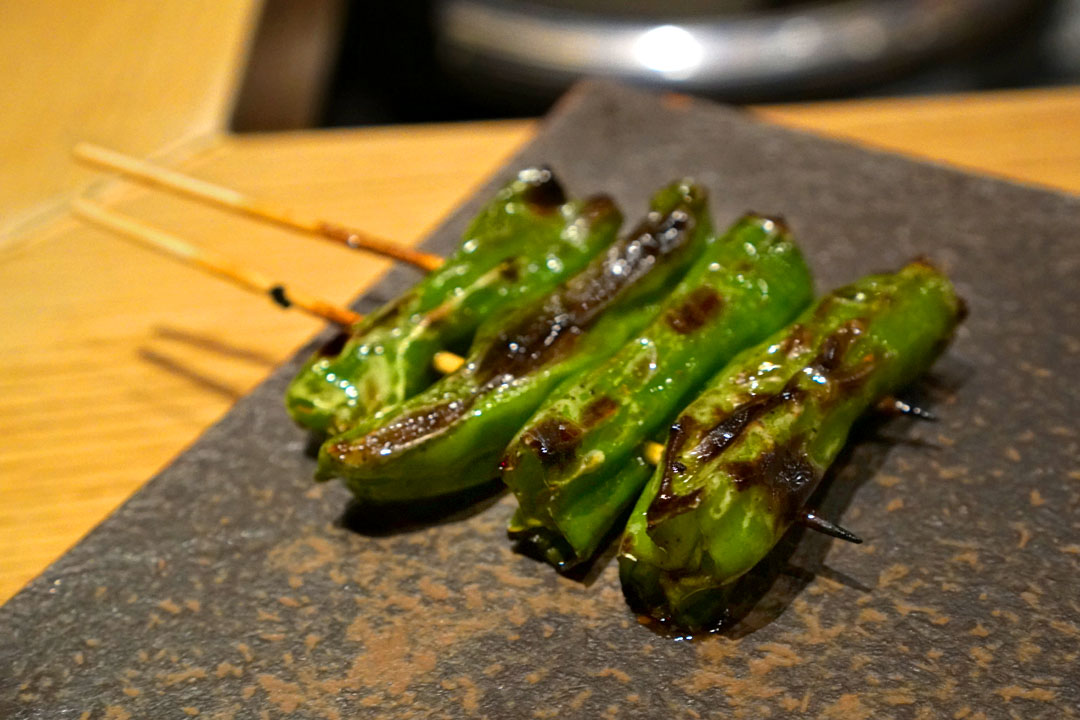
Supplement: Shishito [$8.00]
Shishitos were also on point, the peppers giving up a tasty mélange of sweet, smoky, sour, and savory.

Supplement: Wagyu [$50.00]
A5 wagyu played the sweet, fatty, luscious qualities of the beef against counteracting forces of char and wasabi.
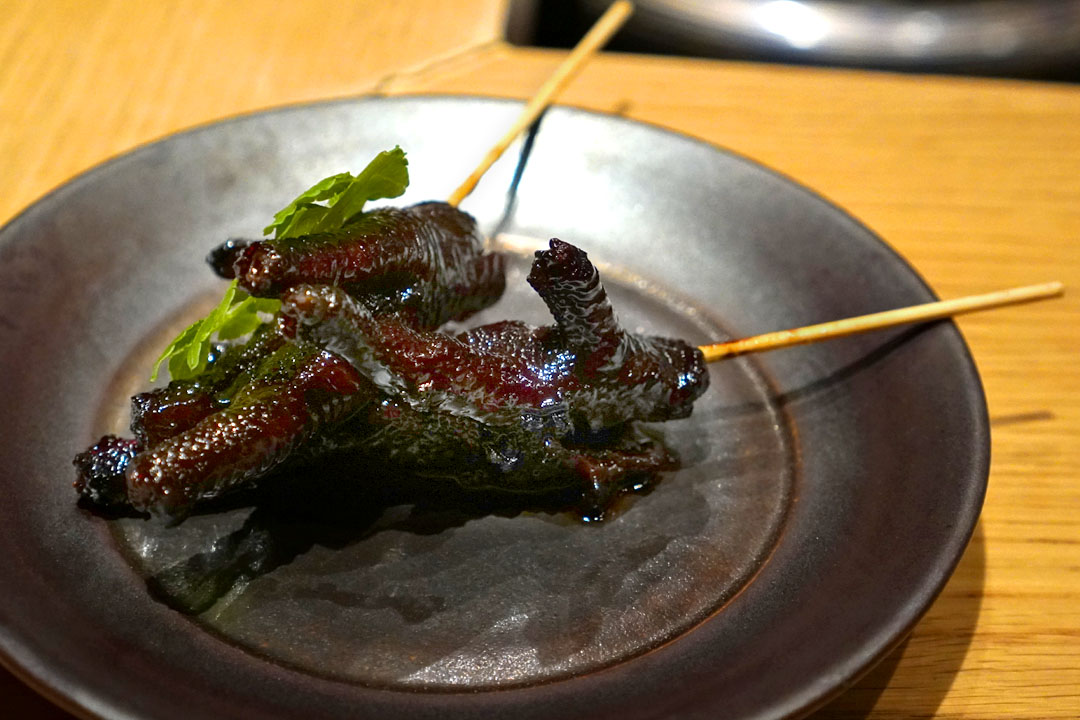
Supplement: Momiji [$12.00]
Chicken feet was another first for me at a yakitori joint. Not surprisingly, the textures were the focal point here, though I quite liked the dish's dark, sticky flavors, too.
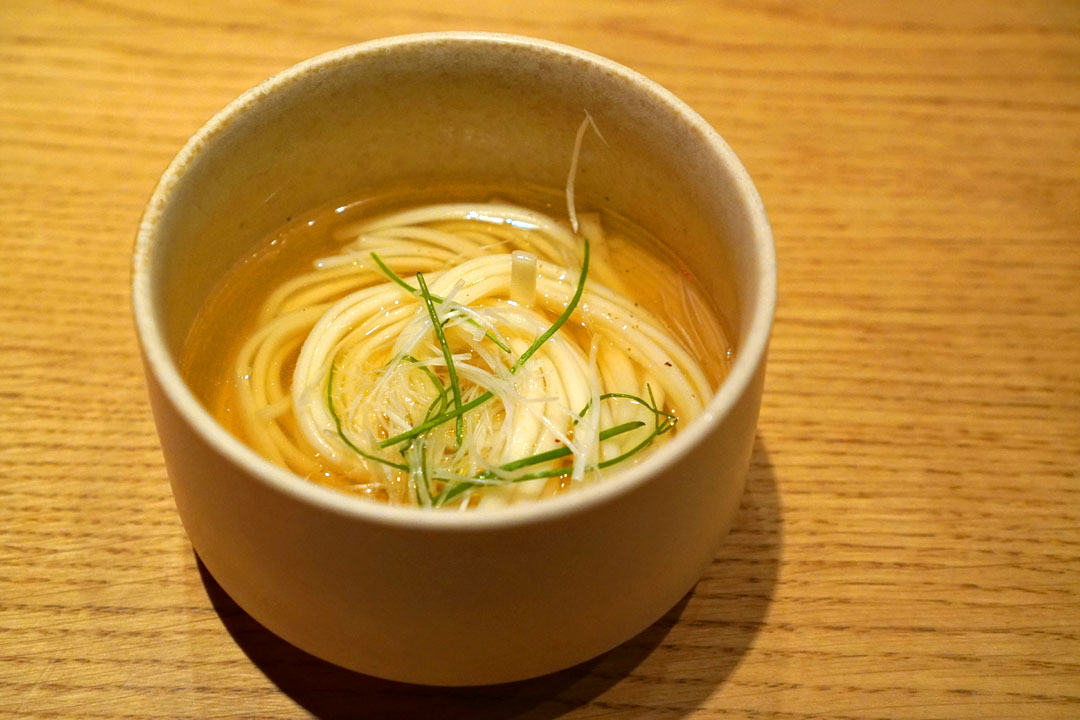
17: Udon
A comfy bowl of udon signaled the end of the skewer parade. The noodles were satisfyingly textured for sure, and really worked as a base for the dish's wonderfully smoky, salty, savory notes, accented by Tokyo negi and what I believe was yuzu. I eagerly supped this up.

18: Kokuto Crème Brûlée
Dessert consisted of a well-caramelized crème brûlée that did a commendable job conveying the rich flavors of Okinawa black sugar.
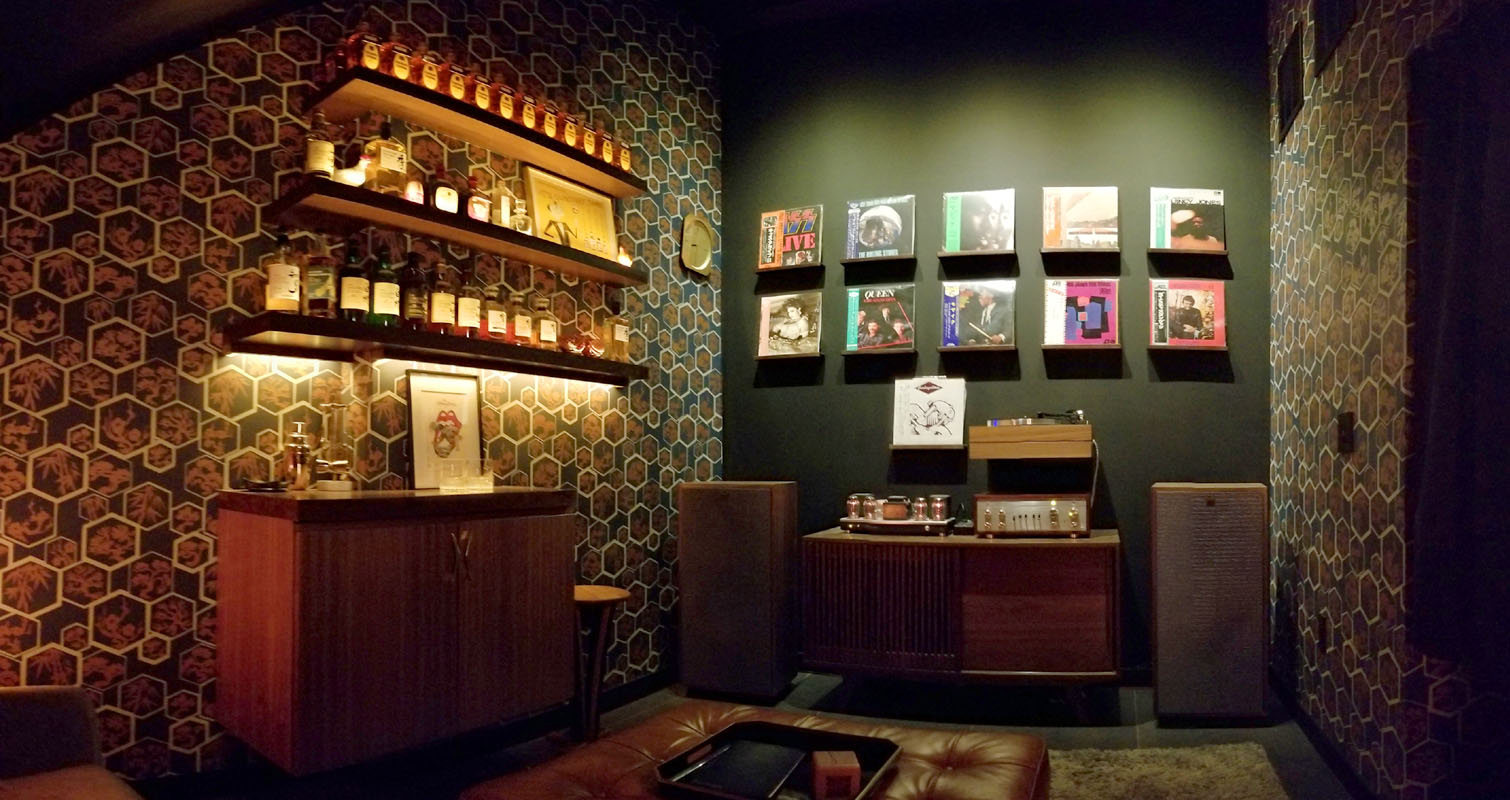
After my meal, I retired into Beatbox, a tiny listening room-slash-Japanese whisky lounge located off to the side of the dining room, which was apparently created in collaboration with Beam Suntory. The place opened on March 21st last year, and offers Kono's full beverage menu in addition to a selection of vinyl to listen to (via Luxman hi-fi components). The music selection seems to focus more on hip-hop and jazz, so unfortunately, the city pop and J-rock I requested weren't available.
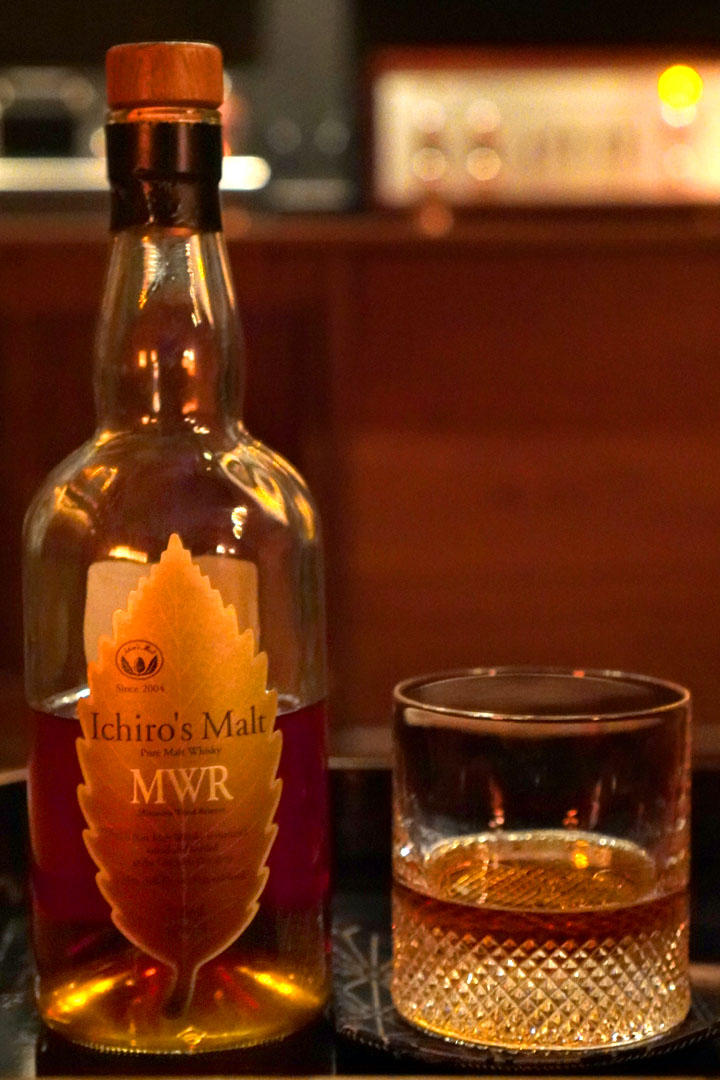
Given my propensity for mizunara cask-finished whisky, my first selection was the Ichiro Pure Malt Mizunara Wood Reserve [$120]. The nose here was all about sweet, woodsy spice supported by layers of zippy fruit and light florals. On the palate, I got sweet orchard fruits commingled with a backbone of smoky wood and pert spices, making for quite an enjoyable drinking experience overall.
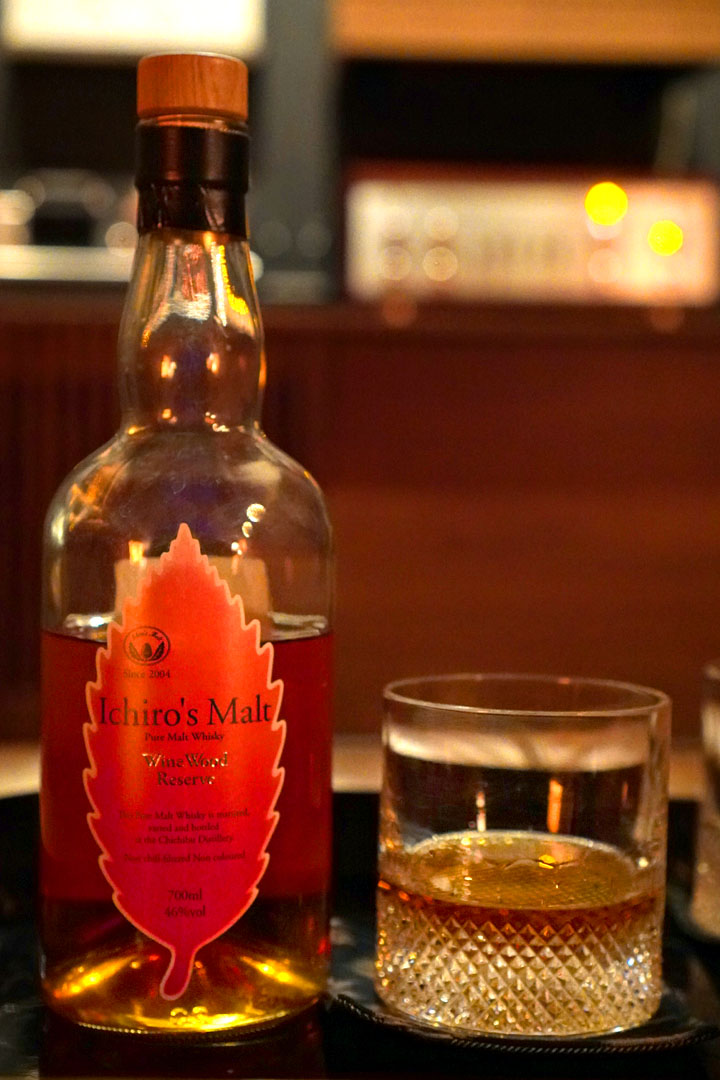
I kept things in the family with my second whisky, which was the Ichiro Pure Malt Wine Wood Reserve [$100], aged in French wine casks. The bouquet here actually demonstrated this baijiu-esque funk, along with a myriad of fruity spices. Taste-wise, think stone fruits abound, commixed with plenty of woodsy spice, raisins, and traces of smoke and cacao.
As I mentioned above, I walked out of Torien thinking that it was the best yakitori meal I've had in the country. After I walked out of Kono, now I'm not so sure. However, what I am sure of is that the top honor has to be between one of these two. Kono-san clearly demonstrated his mastery of the grill tonight, letting each cut of chicken show off its unique charms, and letting me revel in the contrasts in taste, texture, temperature, fat, and sear between them. Now, what actually surprised me was the range of his cooking. The Chef's kappo training was evident, and his non-yakitori courses unquestionably added an extra layer of excitement to the experience that I'm all in favor of. Again, I'd love to have place like this (or Torien) back in Los Angeles.
46 Bowery, New York, NY 10013
646-524-6838
www.yakitorikono.com
Sat 02/24/2024, 05:30p-09:40p

If you read my last post, you'll know that I recently visited Torien, where the team served me the best yakitori meal I've had in the US. However, not content with just one stellar chicken skewer experience, the following day I made my way to Kono, which is oft considered Torien's closest competitor. The Chinatown restaurant bowed in April 2022, and is the brainchild of Atsushi Kono, the former head chef over at yakitori stalwart Torishin.
About the Chef: Kono Atsushi (河野睦/こうのあつし) was born in February 1982, and hails from Kitamoto, Saitama Prefecture. Around age 12, he started helping out at his parents' restaurant and fish market, though he was more interested in b-boying at this point. In fact, he eventually became one of the top breakdancers in Japan, and later taught, choreographed, and even joined the influential Rock Steady Crew in 2002. During this period, he also attended Musashino Culinary Institute, and following completion of his studies, trained at Kyorori Suzuyoshi (京料理 鈴よし), a Kyoto-style kappo in Akasaka, Tokyo. Further training occurred at a Chinese restaurant, at another Japanese spot, and at an outpost of well-regarded Kyoto eatery Tankuma (たん熊).
In 2006, Kono moved to NYC to advance his hip hop and DJ career. However, he needed another job in order to make ends meet, and was thus hired by Chef Shu Ikeda in April 2006 to help with the opening of Yakitori Torishin. He was sent to train at Toriyoshi in Tokyo, which is where Ikeda-san himself apprenticed. Torishin ended up debuting in 2007, and Kono was named head chef there just a year later. During his tenure, the restaurant was awarded a Michelin star (October 2011), which it maintained until the 2019 edition of the guide (released November 2018), and also received a three-star review from Pete Wells over at The New York Times (April 2017). In October 2016, the Chef got married to Nozomi Higashi, and they would later have daughter Kiko in December 2021.
Despite all the acclaim, Kono would leave Torishin in March 2019 to serve as CdC for Michael Jong Lim at Chikarashi Isso, a kappo-inspired offshoot of fast-casual poke spot Chikarashi. Part of Kooth Hospitality (Jonathan Chu, Ivy Tsang, Selwyn Chan, along with Chef Lim), Chikarashi Isso launched in early December 2019 in the Financial District. When the pandemic struck, the Chef pivoted to a Chikarashi Isso-branded yakitori pop-up at Hotel 50 Bowery (developed by Chu's family, a major landlord in the area), which ran from October 2020 to the following July; the actual Chikarashi Isso, meanwhile, closed in late 2021.
By January 2022, he and the Kooth group had already started work on Kono, and the restaurant grand-opened on April 25th that year. Three months later, Pete Wells rated the place three stars, and the following April, the yakitori-ya made its way onto the Times' "100 Best Restaurants" list, at #23. In September 2023, Kono was deemed one of Bon Appetit's "Best New Restaurants," while just this January, Kono was named a "Best Chef: New York State" semifinalist by James Beard.

Kono occupies a space in the 1936-era Canal Arcade building (a.k.a. Chinatown Arcade, and also owned by the Chus) that was previously home to Family Plus Pharmacy. The space was completely re-envisioned by the Chef, in collaboration with BLANK Design, and the room now sports a dark-toned aesthetic inspired by the color of binchotan. Shown above is the view from my seat at one of the corners of the restaurant's 14-seater chef's counter, crafted from white oak and surrounding a sunken grill area. There's also a semi-private table off to the side that can accommodate up to six more guests.


Tonight's yakitori omakase was priced at $175 per person. Unfortunately, you're not provided with an actual menu of the night's dishes, but you do receive the information card above, with a note from Kono-san and a handy chicken diagram (the Chef uses Amish birds I'm told). Click for larger versions.











And here we see Kono's beverage selection, which is managed by GM Louis Andia (ex-Chikarashi Isso). It's pretty respectable, with a suitable array of cocktails, beers, sakes, wines, shochus, and whiskies on offer. Click for larger versions.

1: Consommé
Dinner commenced with a heady, concentrated, comforting chicken bone broth, one perked up by a pervasive ginger tang and threads of zesty scallion. A cozy start for sure.

2: Torikawa, Golden Ossetra Caviar, Tofu Mayo
The saltiness of both Dutch osetra caviar and crispy chicken skin were juxtaposed here, softened by that silky tofu and the refreshing nature of shiso leaf.

3: Shinjo, Bonjiri, Kiku
A shrimp-boosted fish cake conveyed a delectable sweet salinity that was complemented by savory bits of chicken tail. Those robust yet finessed flavors were then matched with edamame and more importantly, a wonderfully grassy chrysanthemum sauce that really uplifted the dish.


4: Reba, Black Truffle, Monaka
A chicken liver pâté ate sweet and earthy, melding perfectly with the musk of Alba truffle and those wafers, which were light, airy, and loaded with this senbei-like savoriness. A bit of a showstopper.

Condiments were sourced from Kyoto-based producer Hararyoukaku (原了郭), and included a classically sharp sansho (粉山椒), as well as kuro shichimi (黒七味), which had this deep, stinging, creeping, surprisingly potent heat that I thoroughly enjoyed.

Rough-grated radish was brightened by the application of shiso.

Seasonal Highball [$17.00] | Suntory Blended Whisky, Soda, Seasonal Fruit
I opted for cocktails this evening, and kicked things off with something on the lighter side. Tonight's seasonal fruit was apricot, and its presentation here was nearly candied, but things never got overly sugary thanks to the drink's boozy, whisky-fueled backbone.

5: Bonjiri
Chicken tail is a favorite of mine, and Chef Kono made a bit of a statement by starting with it, since, given the cut's potency, it's generally served toward the end of a meal. In any case, I found the bird wonderfully salty and smoky, really standing up to the dark pepper, which actually seemed to draw out the bird's sweetness. Yum.

6: Kokoro
The heart was super juicy, with a nice chew and a refined earthiness that really took well to the prickly heat of sansho.

7: Hatsumoto
Arteries had a wonderfully supple bite, along with an initial smokiness transitioning to markedly sweeter flavors. The sansho worked here, but wasn't strictly necessary.

8: Kashiwa
Thigh was great texturally, and came loaded with a mouthwatering sweet char that turned almost fruity when the shichimi was applied. And if you're wondering why this was called kashiwa instead of momo, I was told that the former is the preferred term in the Kansai region.

9: Hizanankotsu
Knee cartilage offered up a gratifying crunch along with a forceful dosing of smoke that really made a lot of sense here. Simply superb.

ATS [$19.00] | Aokage 41 Mugi Shochu, Tare, Grapefruit, Green Tea
My next cocktail was named after the Chef, as "ATS" is his moniker in the b-boy/hip-hop scene. This one wowed me a bit due to its immense, deep, long-lasting savoriness, foiled just enough by the citrus and tea. The drink was also garnished with a shard of fried chicken skin, which imparted further saltiness into the mix.

10: Toro Kawa
Belly skin showed off a tasty mix of fatty and crispy bits, along with a delightful sweetness that meshed effortlessly with elements of char.

Here we Kono-san and his assistant Aki-san (I believe that was his name) working the grill, fired with Kishu binchotan charcoal sourced from Wakayama Prefecture.

11: Harami
Chicken belly was a treat texturally, and was combined with the sweet-n-sour nature of ume paste and the unmistakable brightness of shiso.

12: Amigasatake
Himalayan morels were intensely woodsy, and married perfectly with a savory tare sauce and even better with the dish's healthy dosing of butter.

13: Soriresu
Chicken oysters showcased a fantastically slick, tender texture and a robust flavor profile that was further heightened by yuzukosho and plenty of char on the skin. This is apparently one of the Chef's signature skewers, and I can see why.

Kiko [$19.00] | Daiyame 25 Imo Shochu "Lychee", Italicus
This next cocktail took its name from Kono-san's daughter. The drink was well integrated, effortlessly combining loads of floral, sugary nuances with a marked bitterness from the bergamot liqueur.

14: Ichijiku
I'd never seen fig before at a yakitori-ya, but the fruit worked out quite nicely due to how its sweetness paired with the nuttiness of a miso sauce.

15: Tori Katsu
The chicken katsu was also unexpected. I was a fan of the bird's spot-on panko crust, while its juicy, savory interior played well with the sugariness of apple sauce.



16: Tsukune + Alba Truffle [+35.00]
Meatballs were comprised of duck breast and chicken thigh, and delivered in spades both in terms of taste and texture. The addition of a seaweed wrapper was also appreciated, as was that runny egg yolk. And as for those musky shavings of black truffle? Did the dish need them? No. But was it better with them? Oh yeah.

At this point, I was presented with a case of optional items to supplement my meal with. Not surprisingly, I added on each and every one. However, I will say that venturing into other meats (i.e. pork, beef) isn't really necessary, since Kono-san's chicken is easily strong enough on its own.

Supplement: Reba [$10.00]
Liver was cooked rarer than usual, which I much prefer, and thus ate softer and slicker than one typically finds, while the organ's signature earthiness was set off beautifully by pinpricks of salt.

B-Boy [$19.00] | Infused Toki Whisky, Campari, Archivo Volume Primo
A nod to Kono-san's breakdancing past, this cocktail highlighted the bitterness of the Campari-vermouth duo up front, before transitioning to a cacao-esque sweetness interspersed with a baijiu-like earthiness.

Supplement: Seseri [$12.00]
Chicken neck was a textural treat, and demonstrated a mouthwatering saltiness that was somehow tempered by all the smoke going on.

Supplement: Sunagimo [$8.00]
The gizzard was my server's favorite skewer, and I can see why. I just loved the sheer crunch of the offal, not to mention its agreeably salt-n-peppery flavors.

Supplement: Jinzo [$12.00]
Chicken kidney was a new one for me. I found it chewy and sinewy, with a liver-like earthiness that served as a great foil for contrasting elements of sweetness and sear.

Supplement: Eringi [$12.00]
Eryngi mushrooms conveyed a powerful, woodsy umami, and combined like clockwork with the dish's buttery components and a garnish of fried shiso.

Supplement: Ibérico [$25.00]
Shards of ibérico had that porcine depth I was looking for, and really opened up when taken with the sting of yuzukosho.

Gold Fashioned [$19.00] | Legent Bourbon, Golden Orange Honey
My final cocktail was an old fashioned variation, and featured a wonderfully woodsy, aromatic smoke, alongside a bevy of sweet, bitter, and boozy nuances.

Supplement: Shishito [$8.00]
Shishitos were also on point, the peppers giving up a tasty mélange of sweet, smoky, sour, and savory.

Supplement: Wagyu [$50.00]
A5 wagyu played the sweet, fatty, luscious qualities of the beef against counteracting forces of char and wasabi.

Supplement: Momiji [$12.00]
Chicken feet was another first for me at a yakitori joint. Not surprisingly, the textures were the focal point here, though I quite liked the dish's dark, sticky flavors, too.

17: Udon
A comfy bowl of udon signaled the end of the skewer parade. The noodles were satisfyingly textured for sure, and really worked as a base for the dish's wonderfully smoky, salty, savory notes, accented by Tokyo negi and what I believe was yuzu. I eagerly supped this up.

18: Kokuto Crème Brûlée
Dessert consisted of a well-caramelized crème brûlée that did a commendable job conveying the rich flavors of Okinawa black sugar.

After my meal, I retired into Beatbox, a tiny listening room-slash-Japanese whisky lounge located off to the side of the dining room, which was apparently created in collaboration with Beam Suntory. The place opened on March 21st last year, and offers Kono's full beverage menu in addition to a selection of vinyl to listen to (via Luxman hi-fi components). The music selection seems to focus more on hip-hop and jazz, so unfortunately, the city pop and J-rock I requested weren't available.

Given my propensity for mizunara cask-finished whisky, my first selection was the Ichiro Pure Malt Mizunara Wood Reserve [$120]. The nose here was all about sweet, woodsy spice supported by layers of zippy fruit and light florals. On the palate, I got sweet orchard fruits commingled with a backbone of smoky wood and pert spices, making for quite an enjoyable drinking experience overall.

I kept things in the family with my second whisky, which was the Ichiro Pure Malt Wine Wood Reserve [$100], aged in French wine casks. The bouquet here actually demonstrated this baijiu-esque funk, along with a myriad of fruity spices. Taste-wise, think stone fruits abound, commixed with plenty of woodsy spice, raisins, and traces of smoke and cacao.
As I mentioned above, I walked out of Torien thinking that it was the best yakitori meal I've had in the country. After I walked out of Kono, now I'm not so sure. However, what I am sure of is that the top honor has to be between one of these two. Kono-san clearly demonstrated his mastery of the grill tonight, letting each cut of chicken show off its unique charms, and letting me revel in the contrasts in taste, texture, temperature, fat, and sear between them. Now, what actually surprised me was the range of his cooking. The Chef's kappo training was evident, and his non-yakitori courses unquestionably added an extra layer of excitement to the experience that I'm all in favor of. Again, I'd love to have place like this (or Torien) back in Los Angeles.
2 Comments:
As much as Americans talk about "nose to tail" cooking, in comparison to most global cuisines it feels they are far behind?
Some of these animal parts this restaurant is using are amazing, even to a European like me.
Speaking broadly, yes, I believe that you're correct. In addition, I feel like the whole "nose-to-tail" trend has fallen out of favor in the past decade or so. I don't hear chefs talking about it nearly as much these days.
Post a Comment
Subscribe to Post Comments [Atom]
<< Home